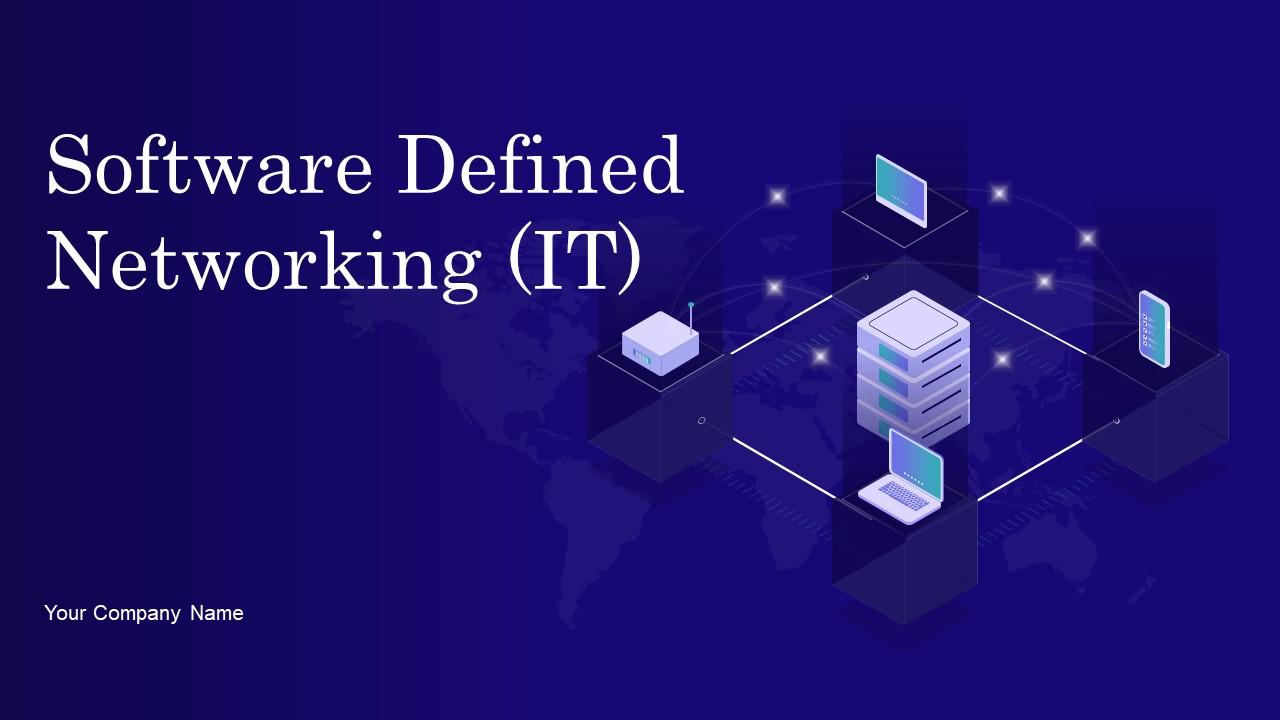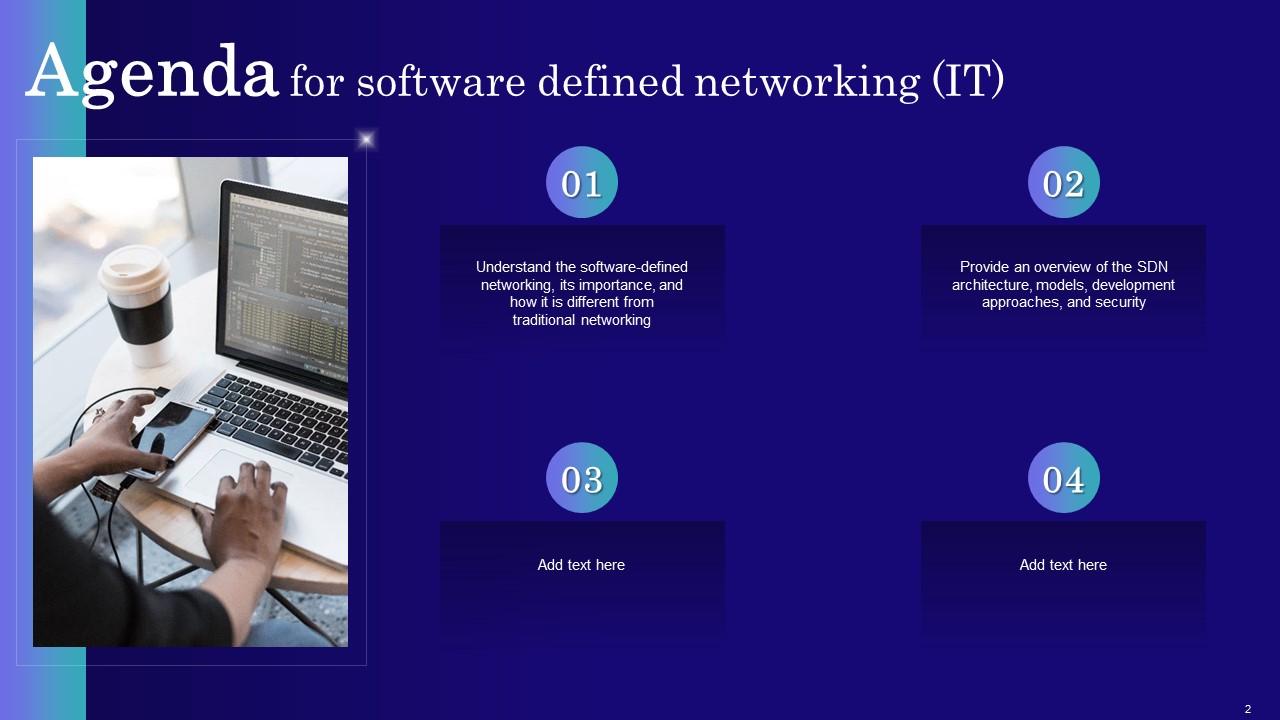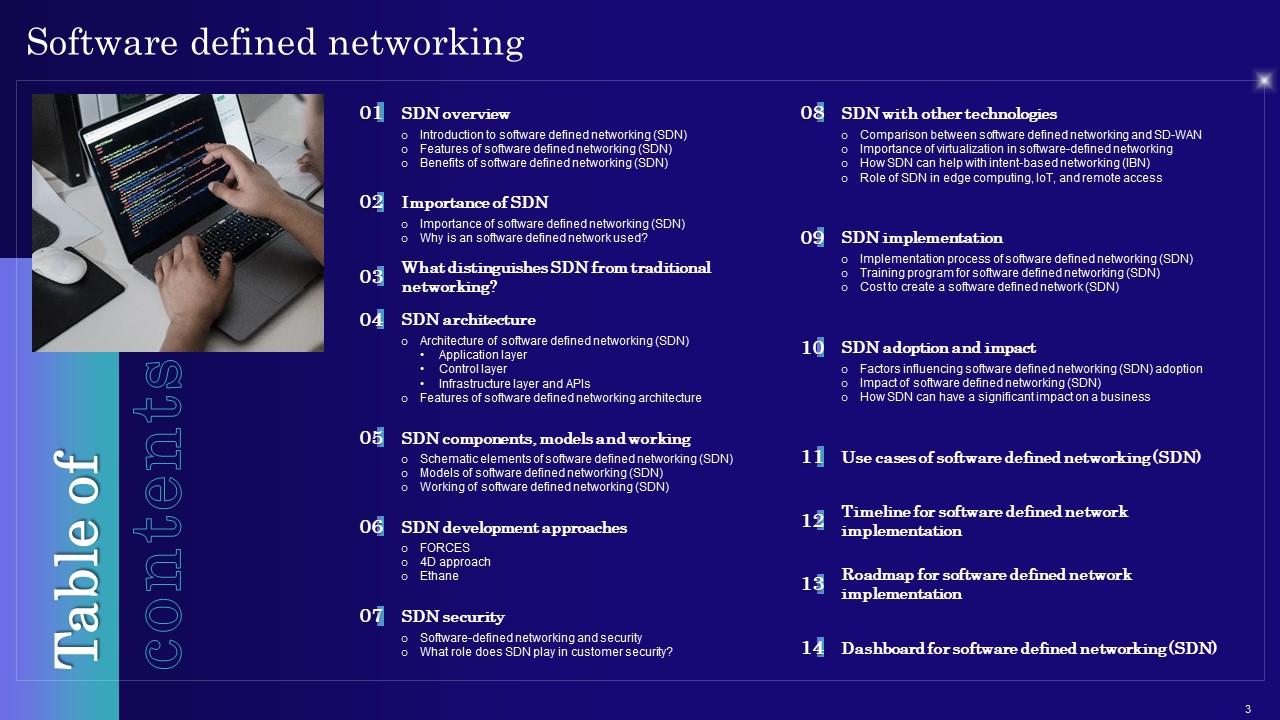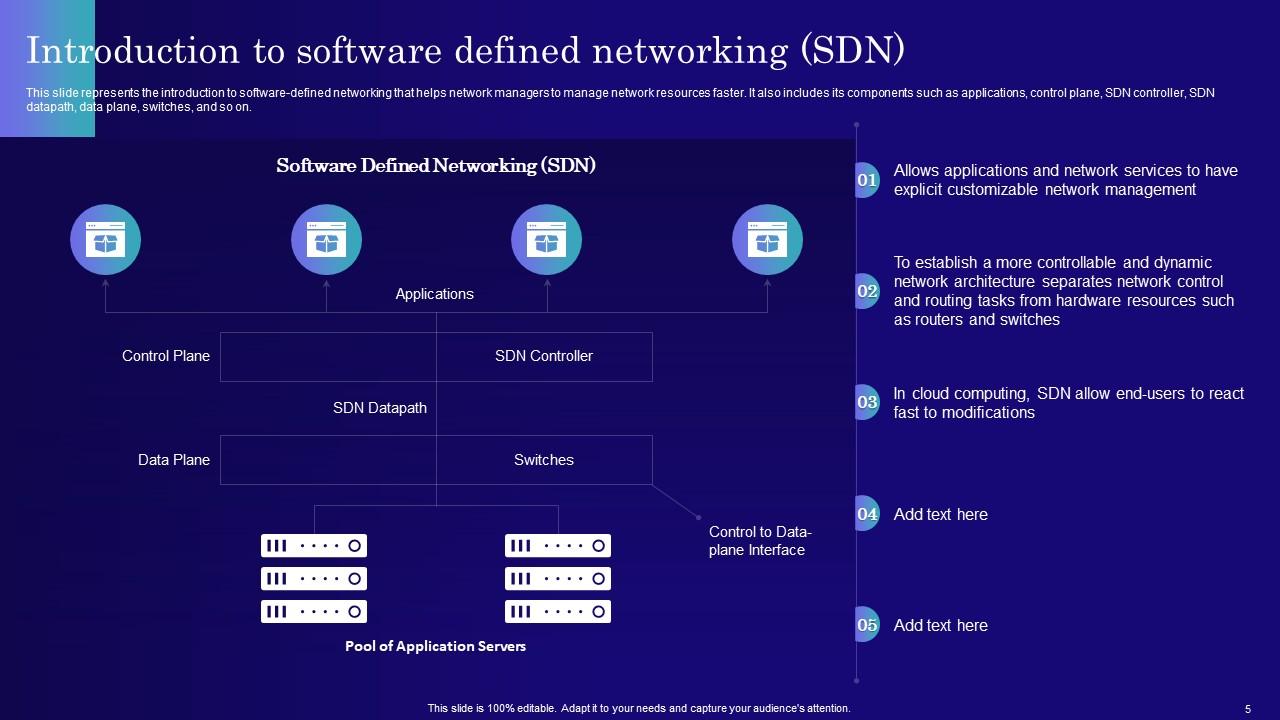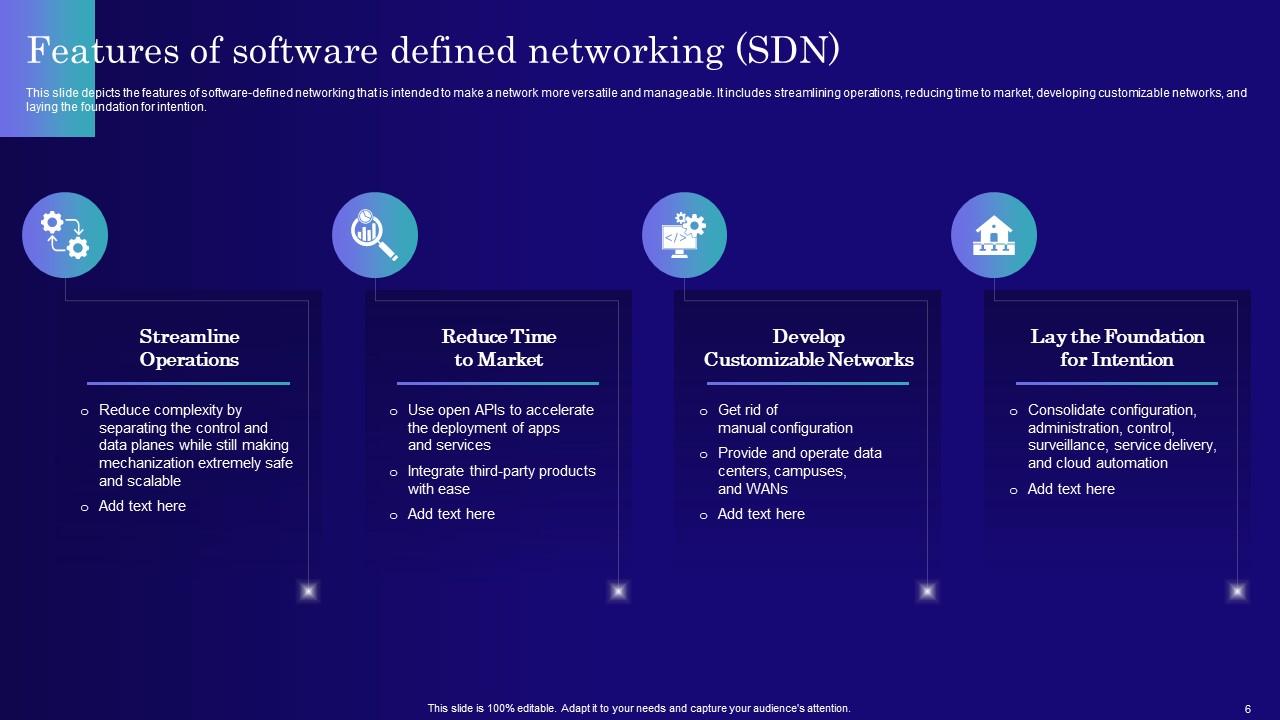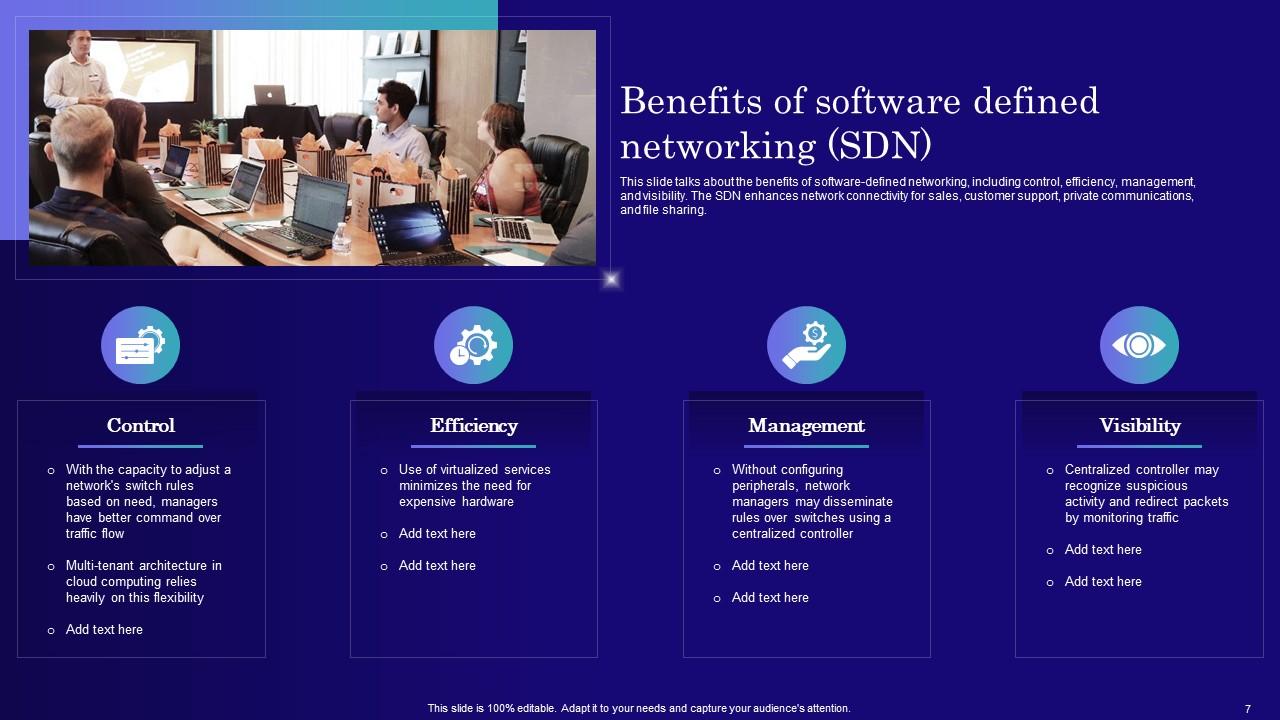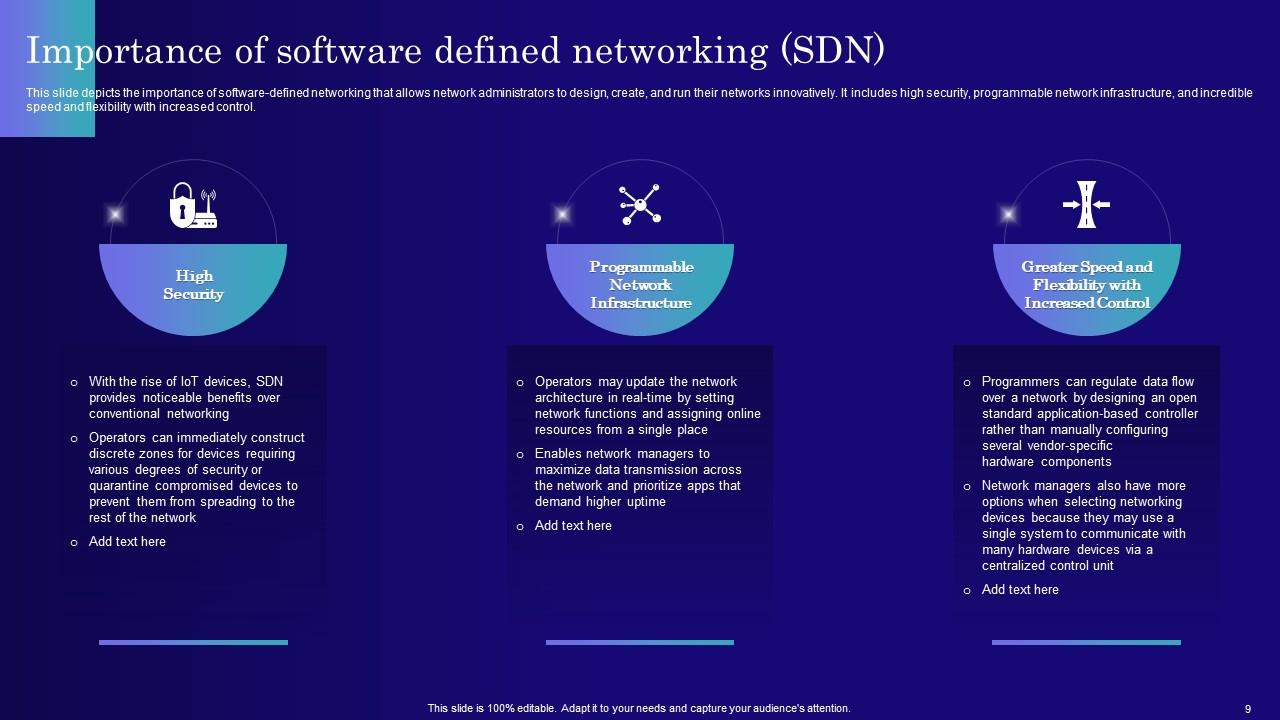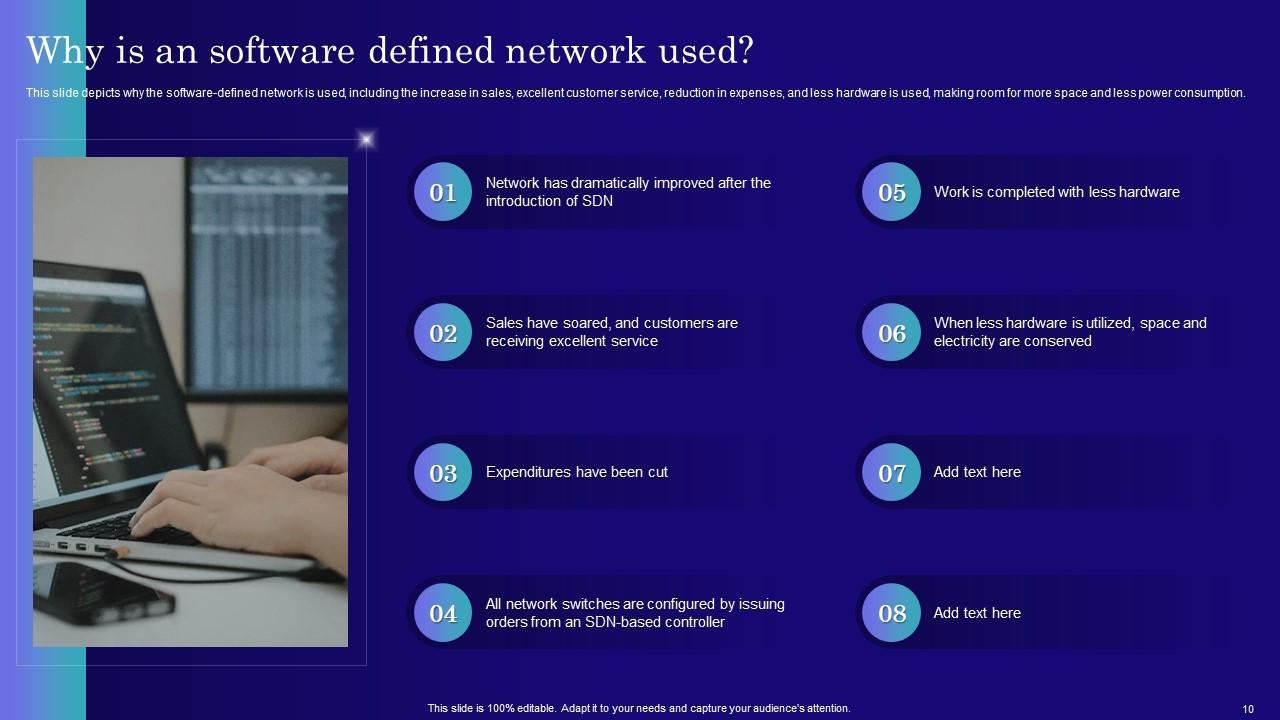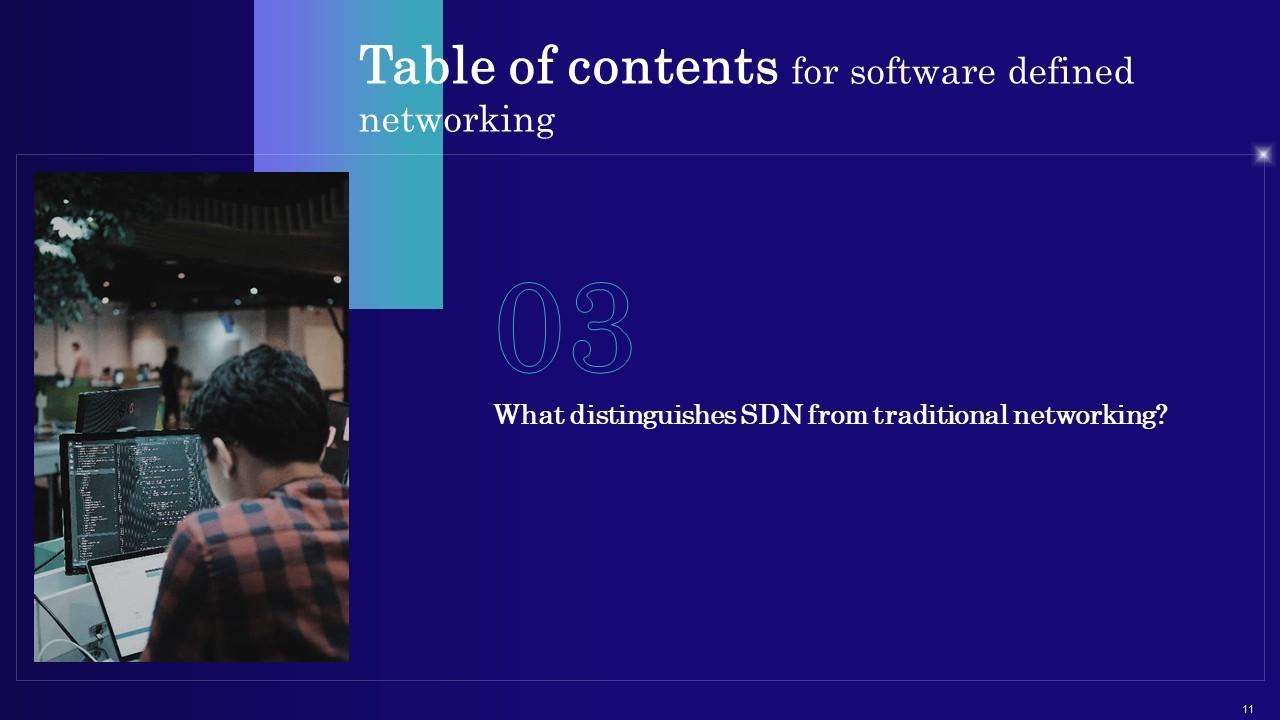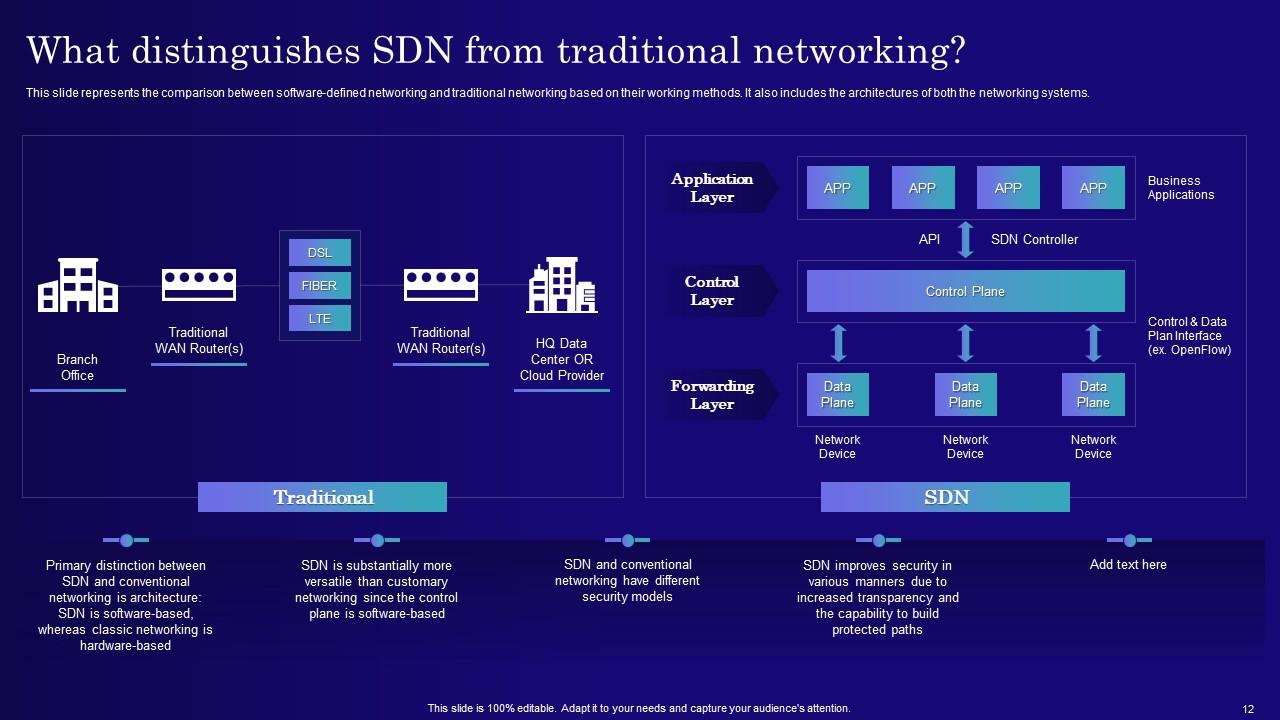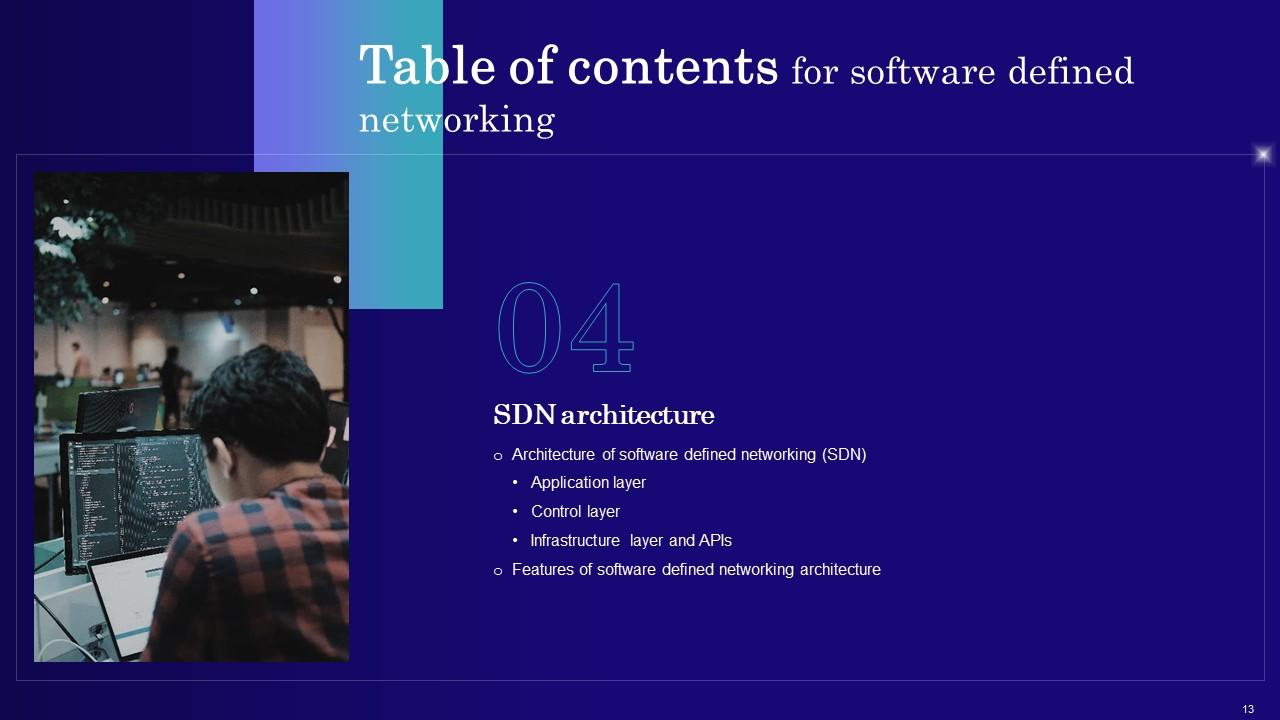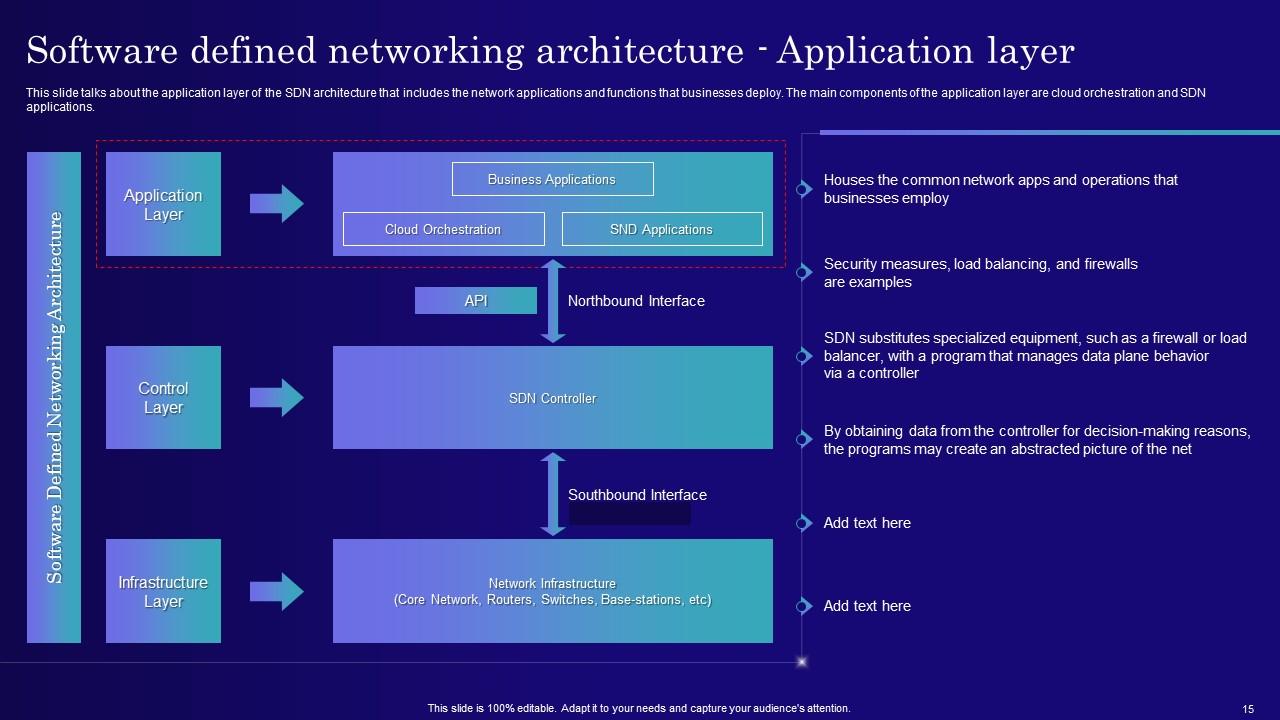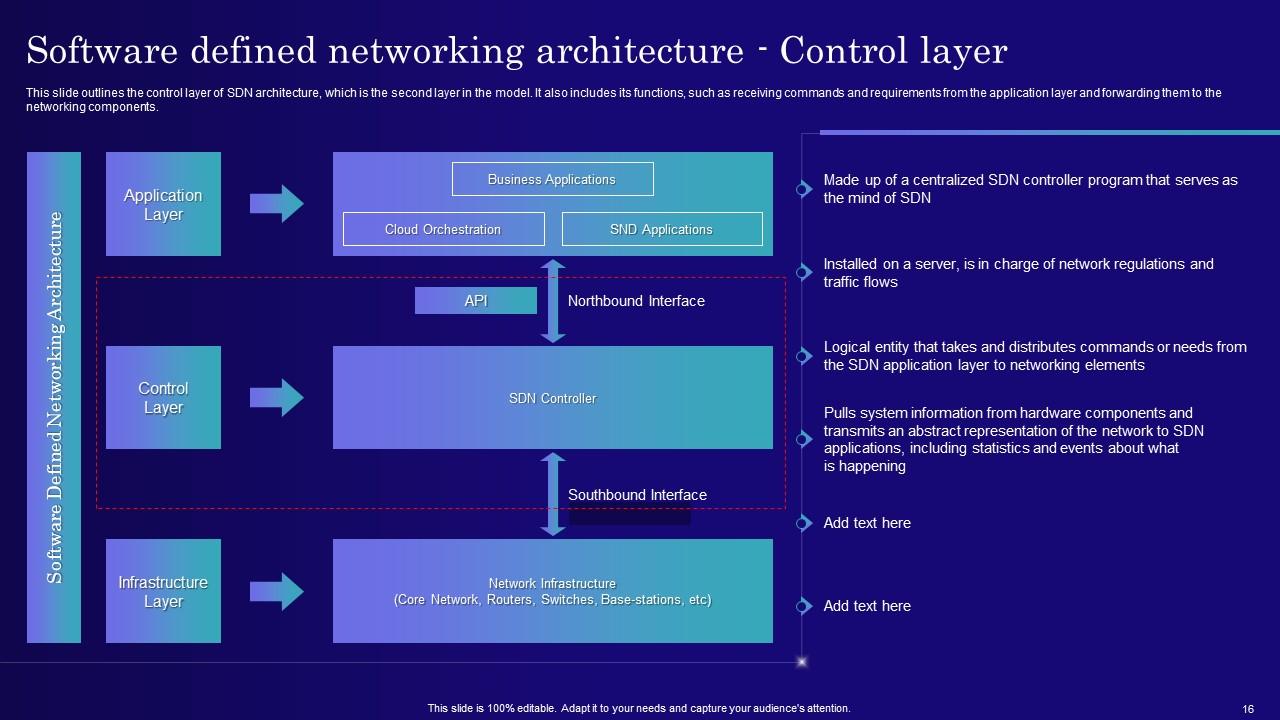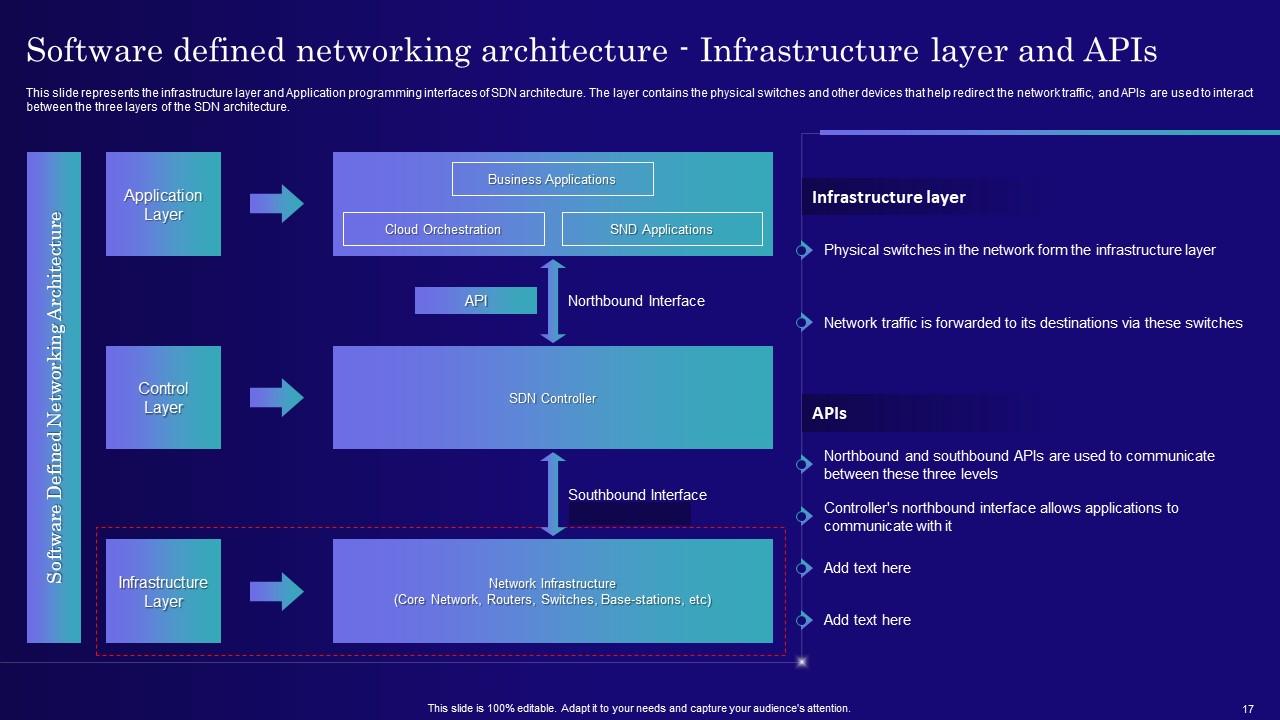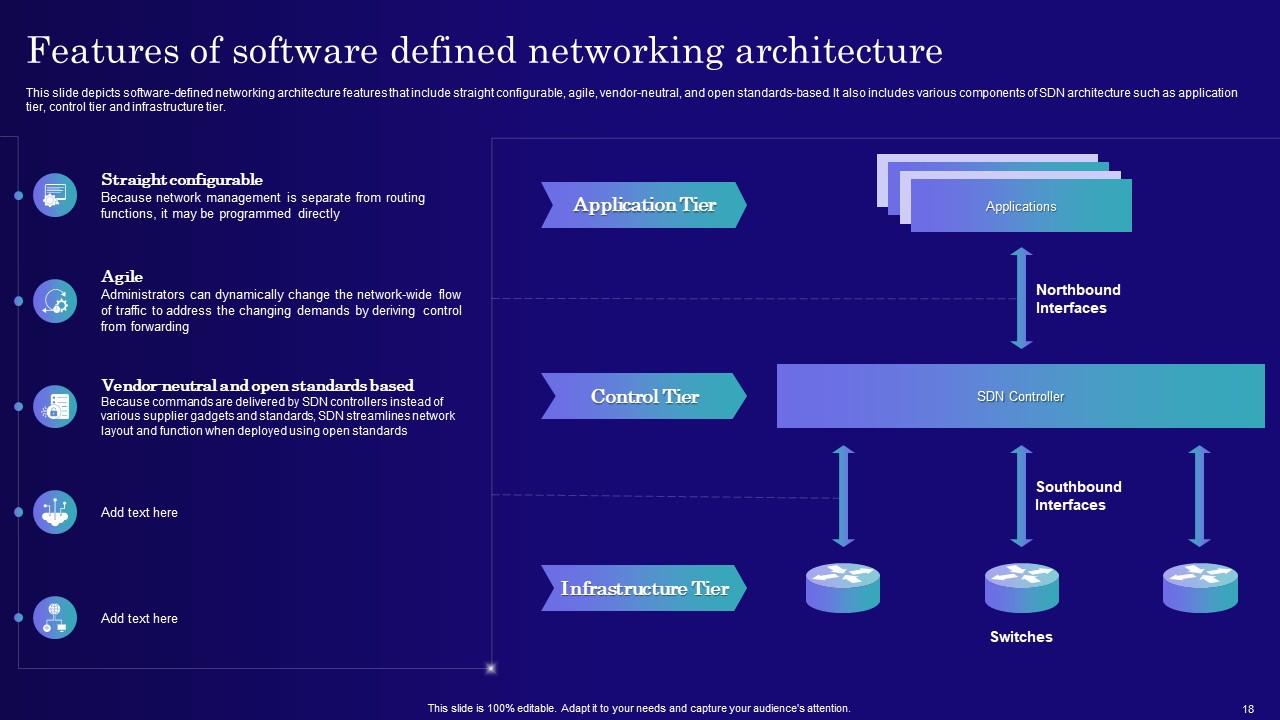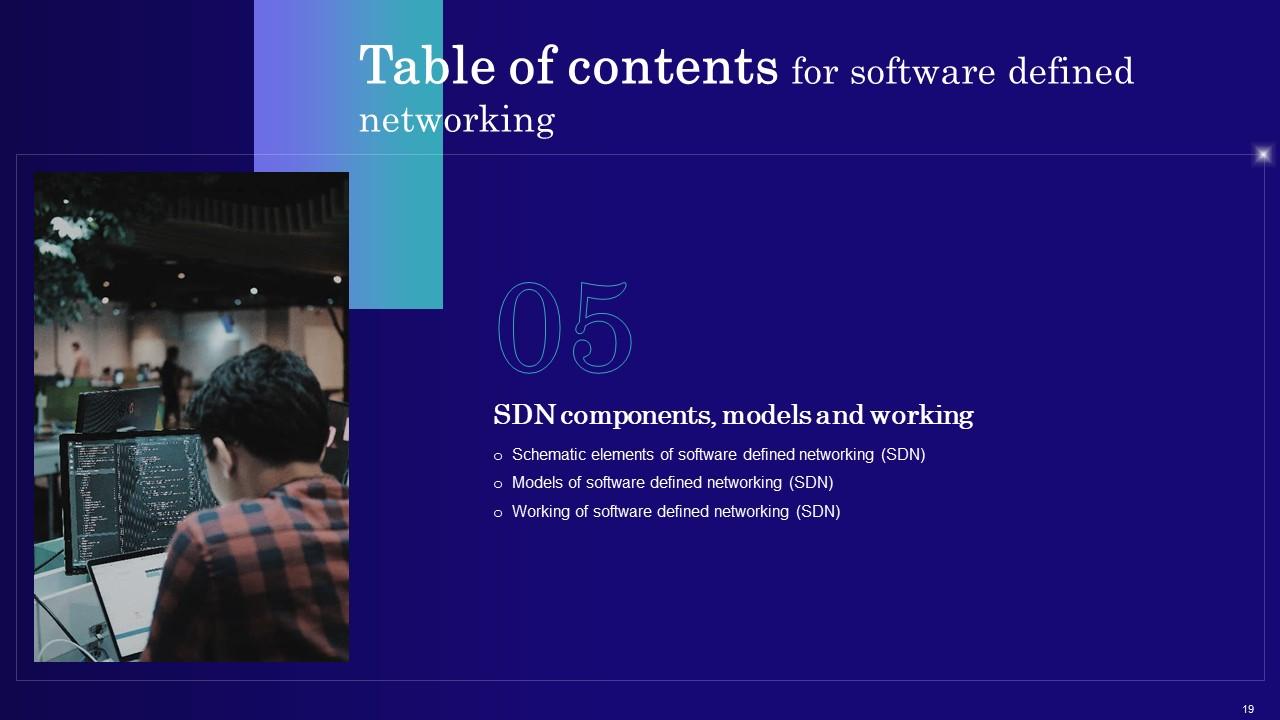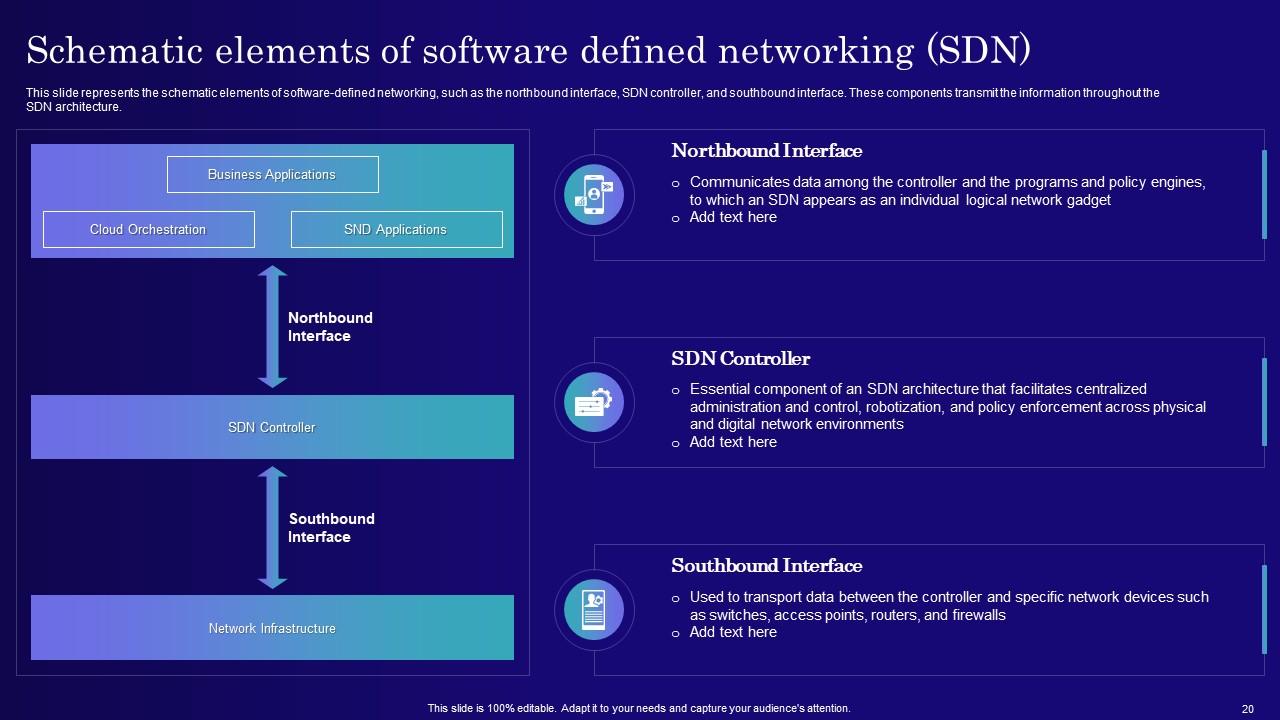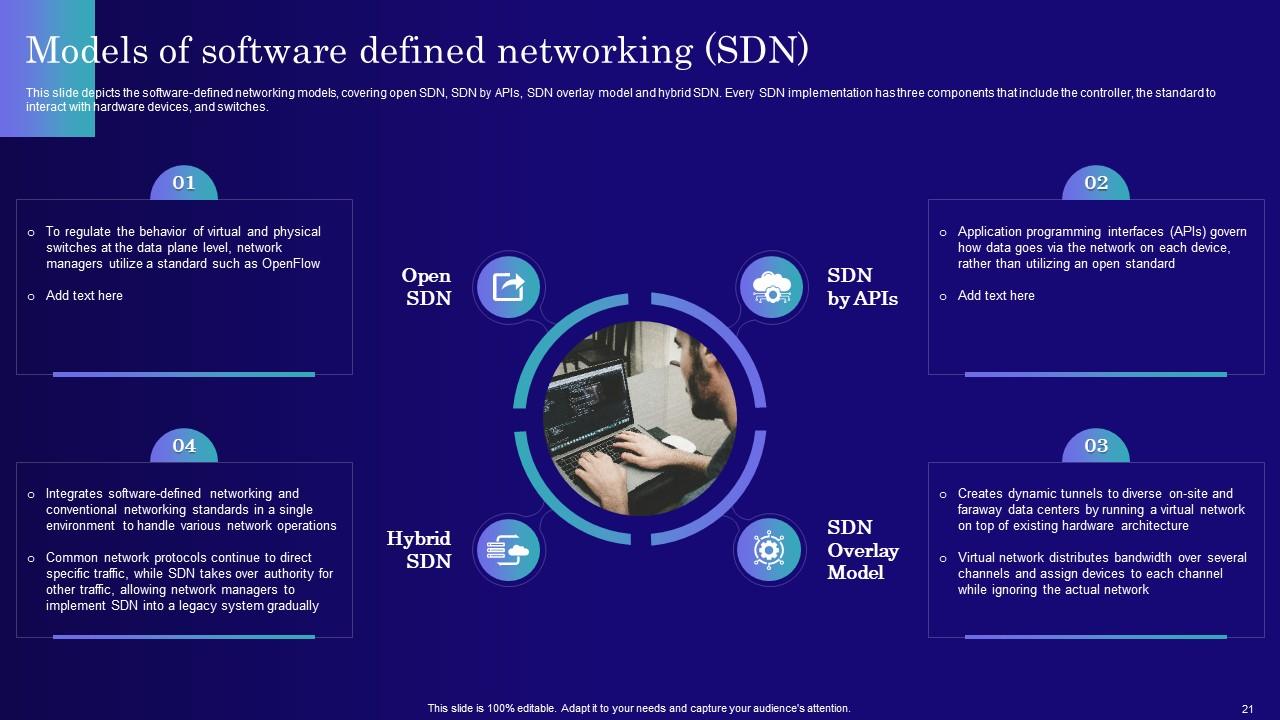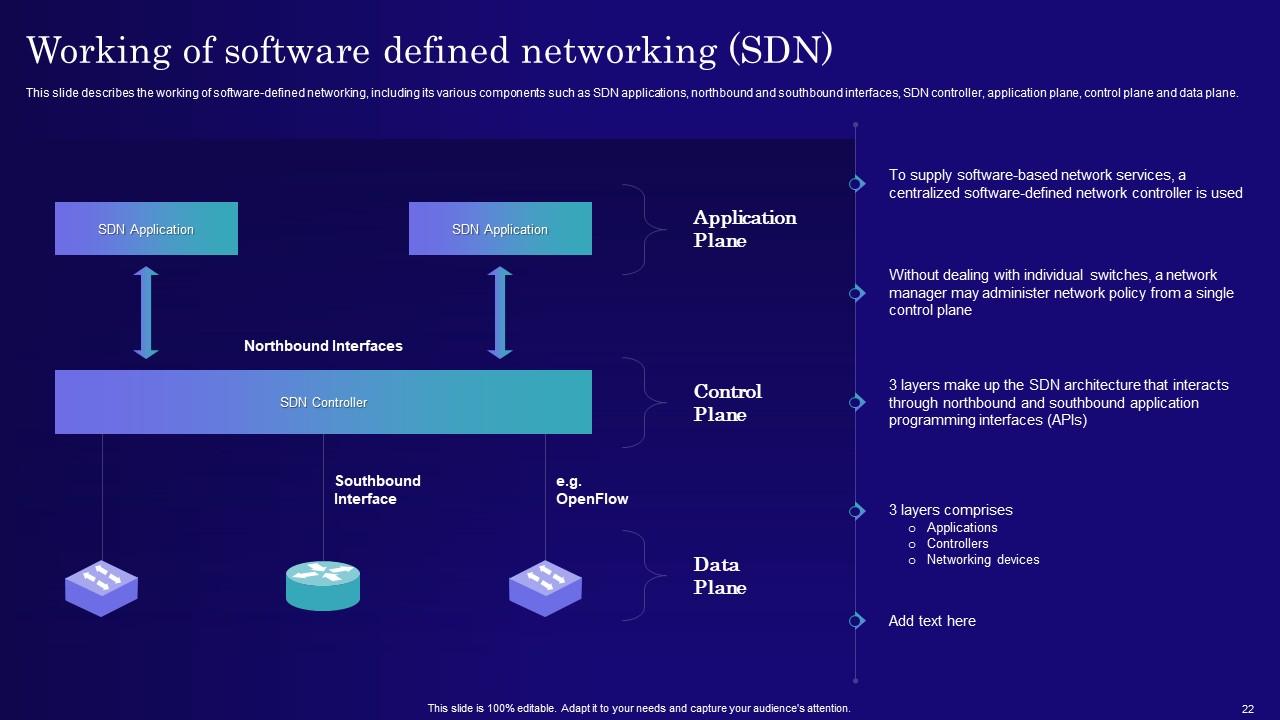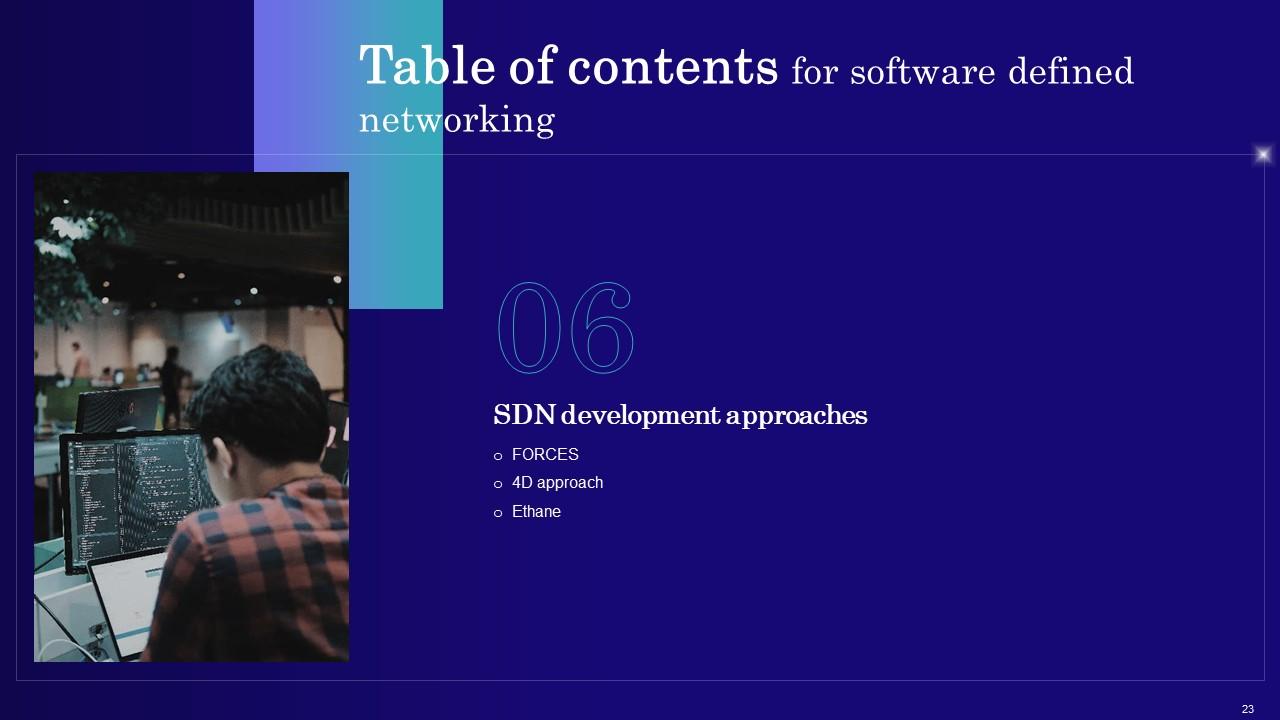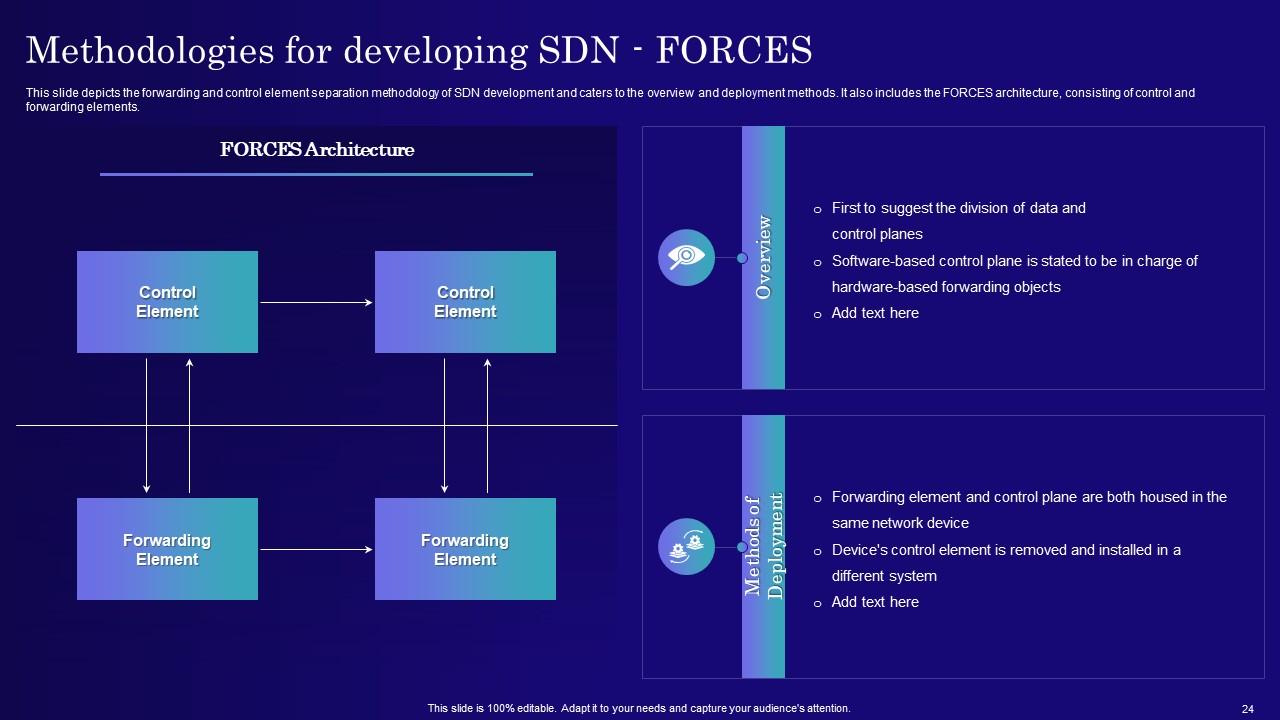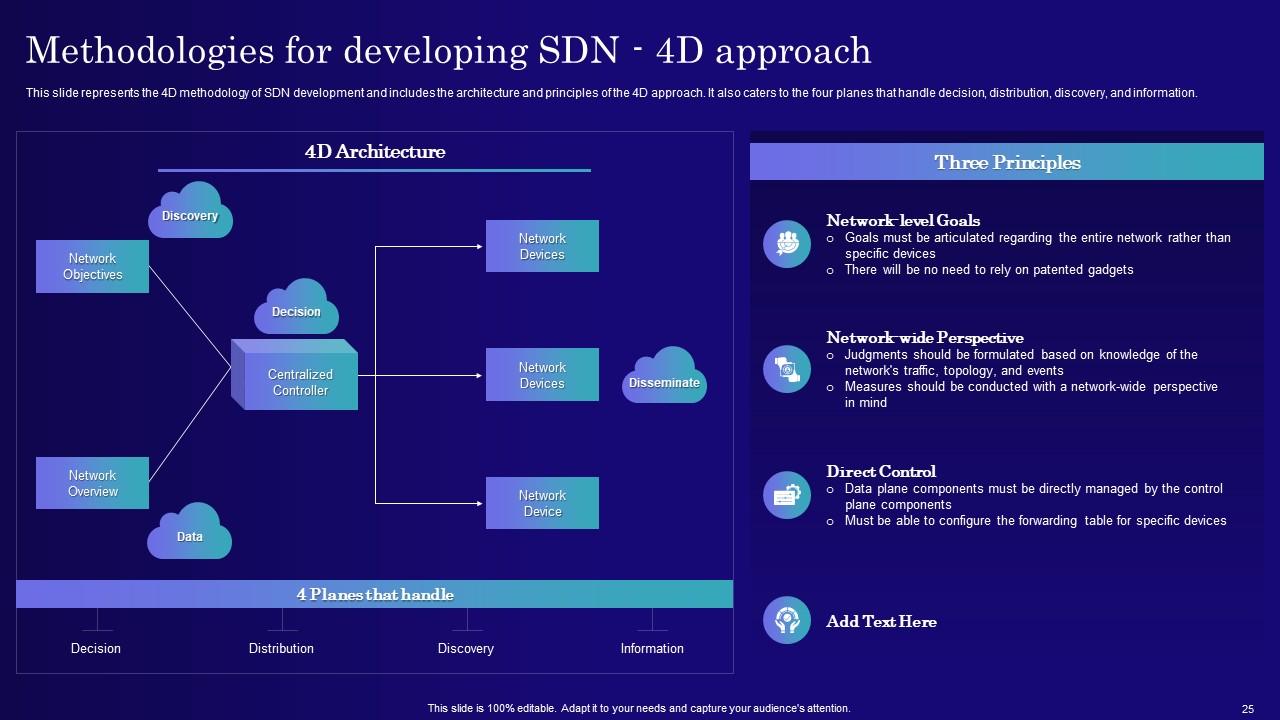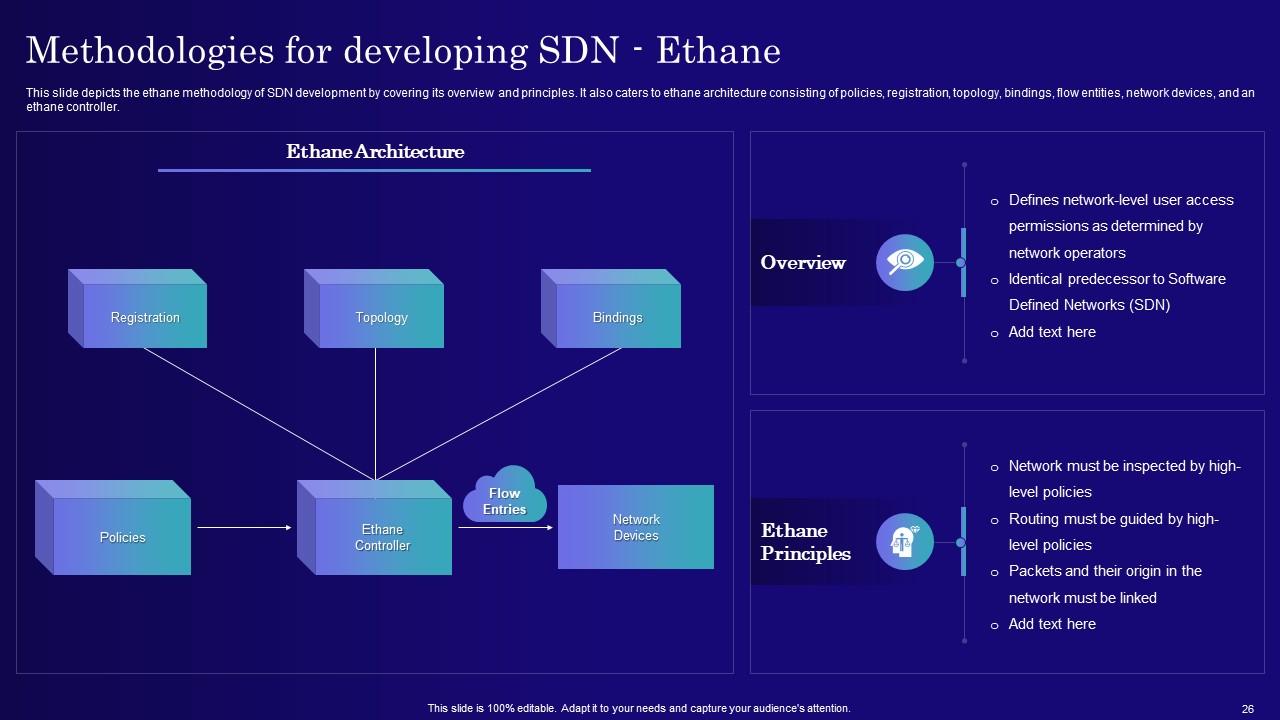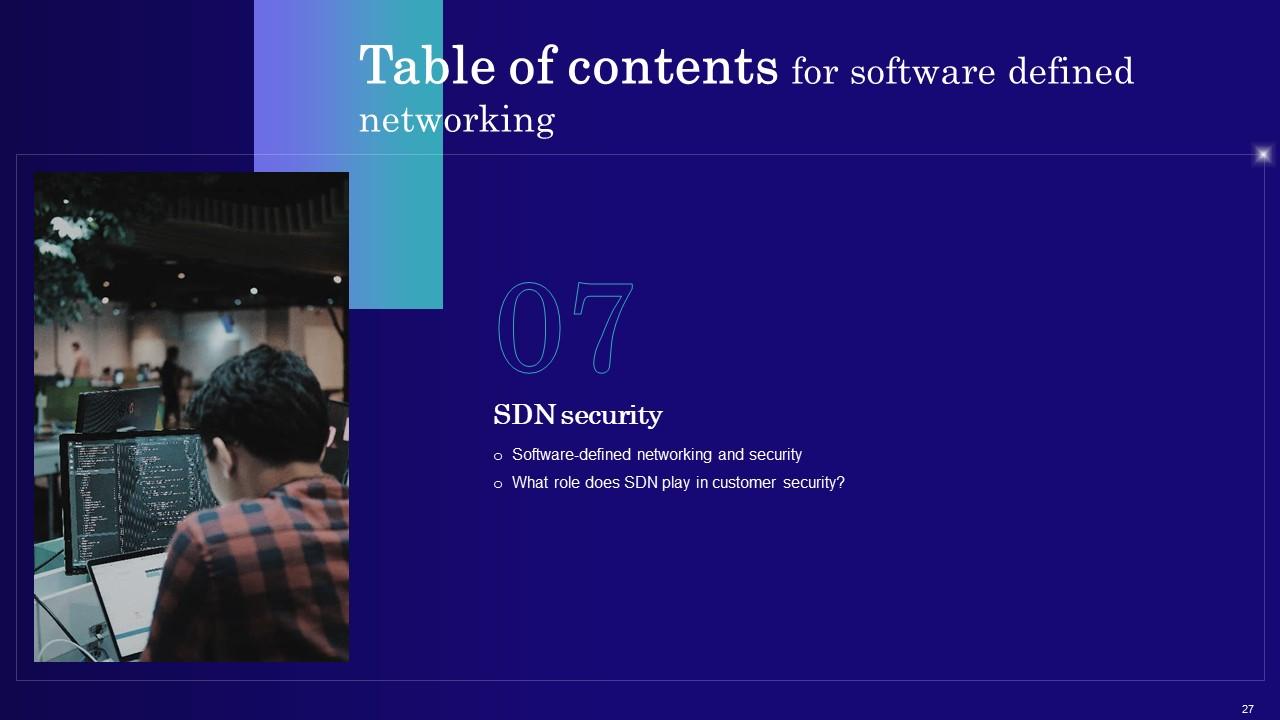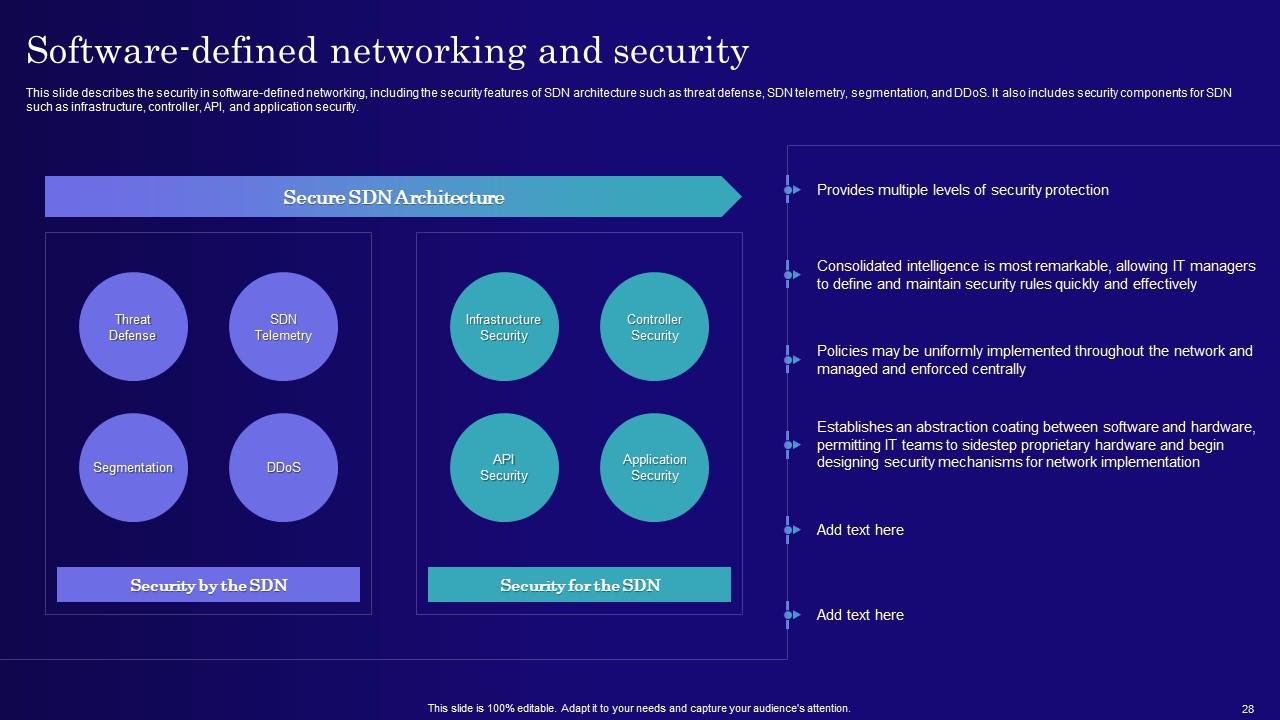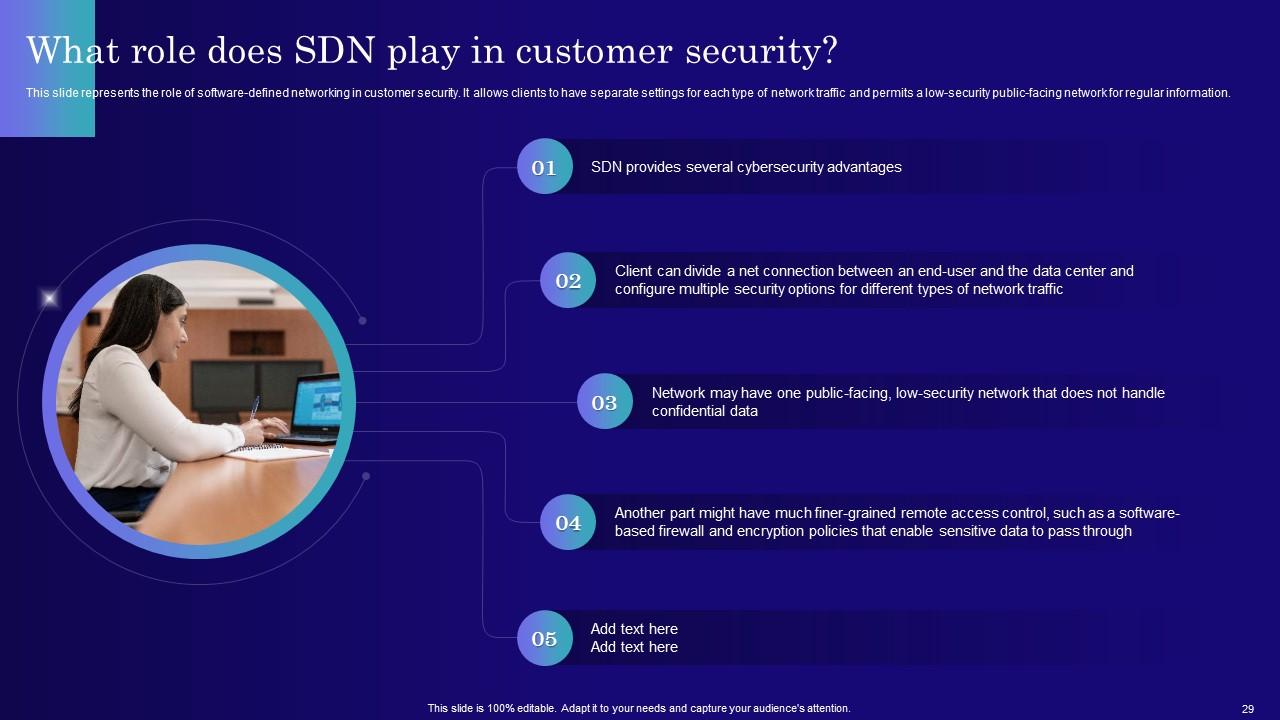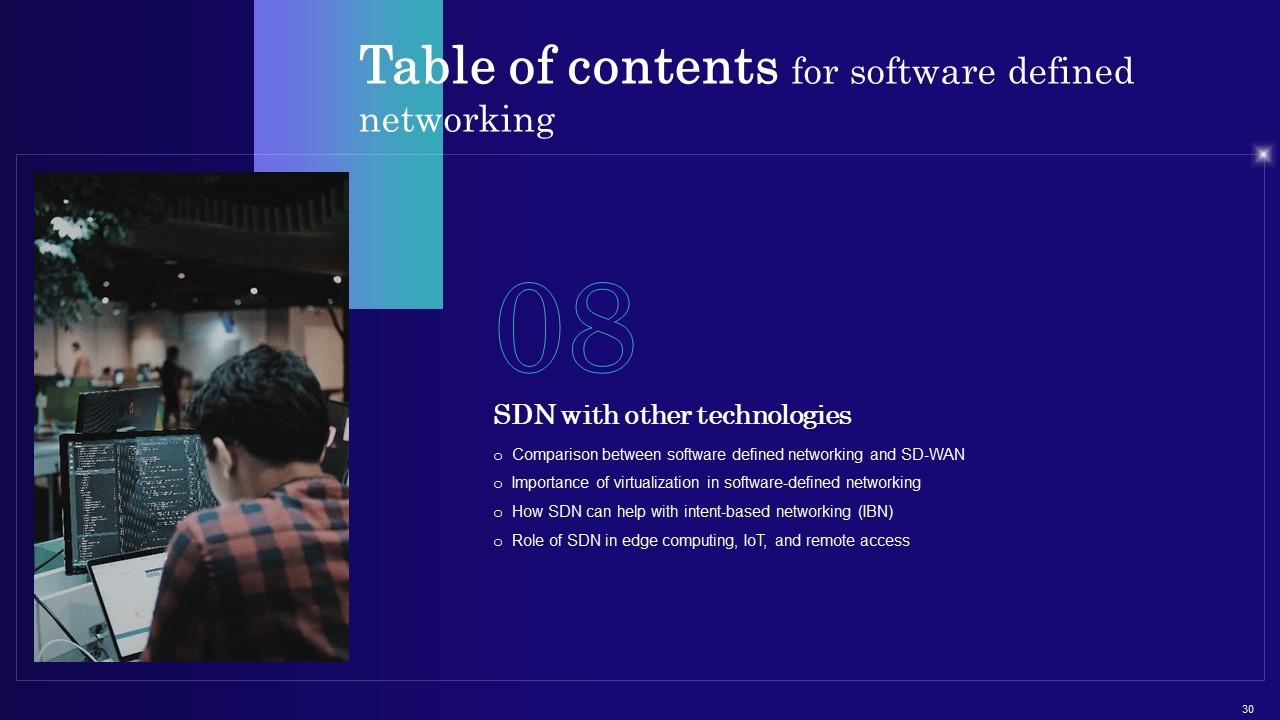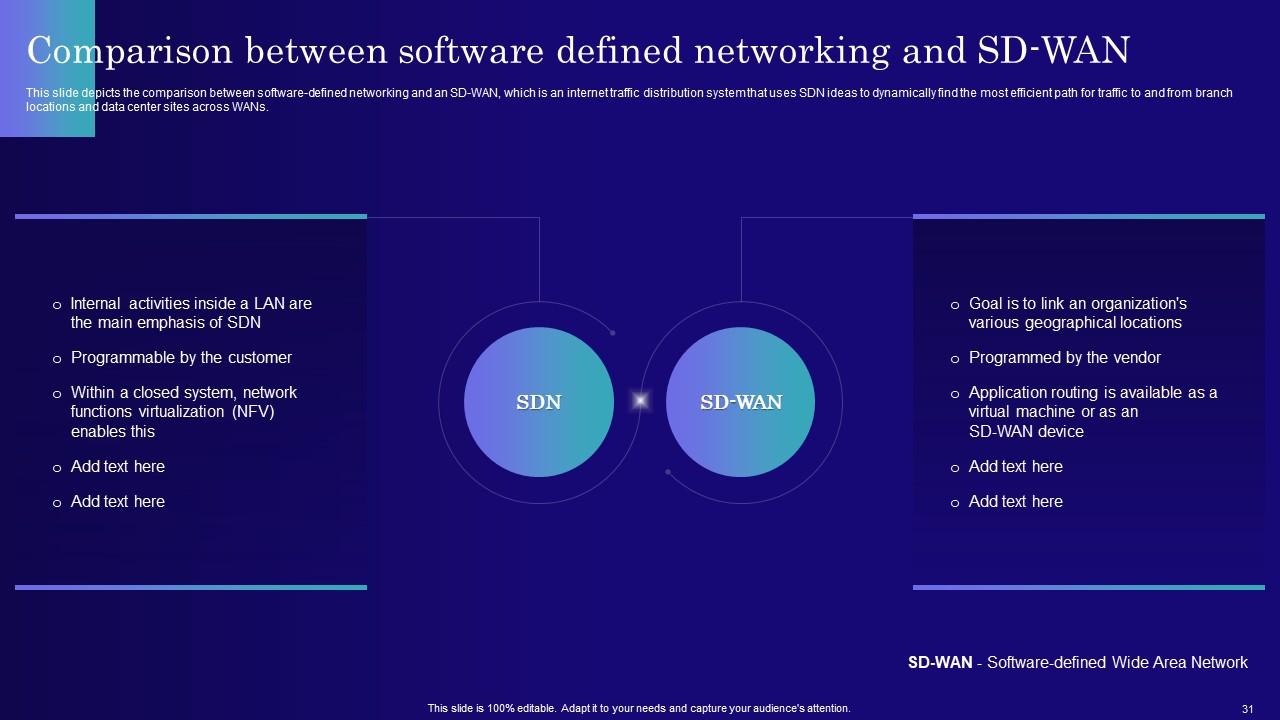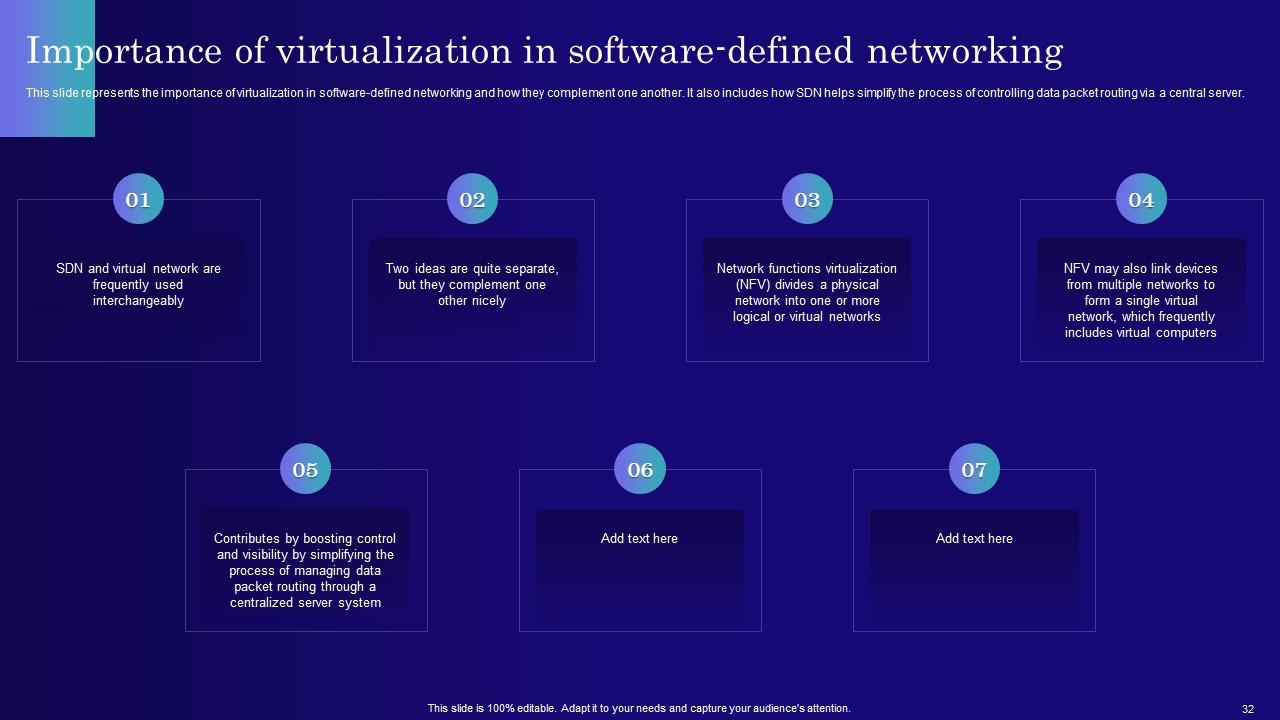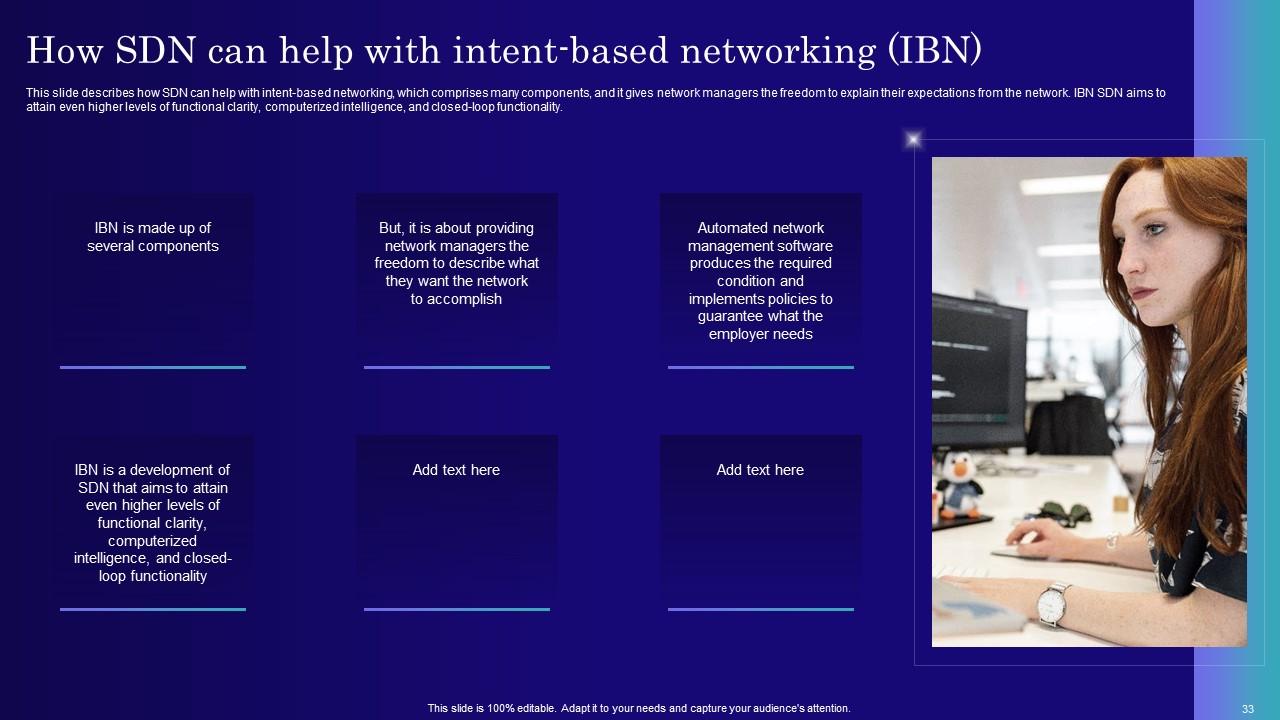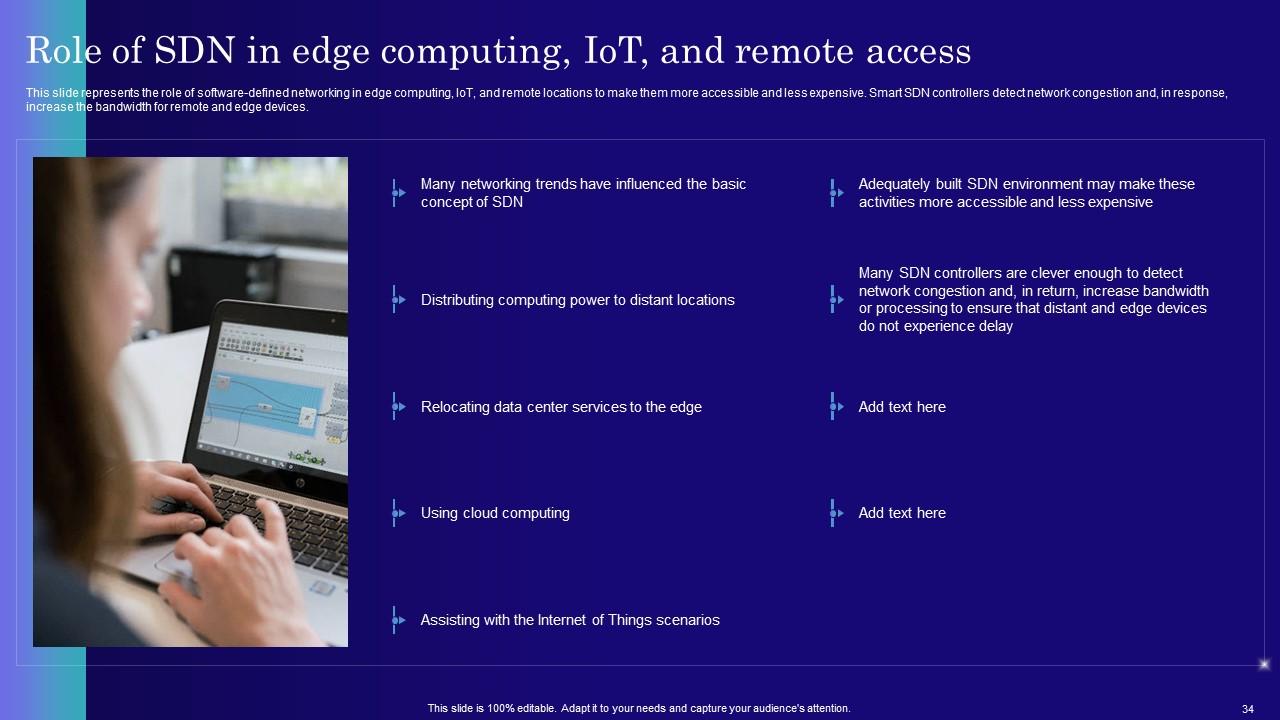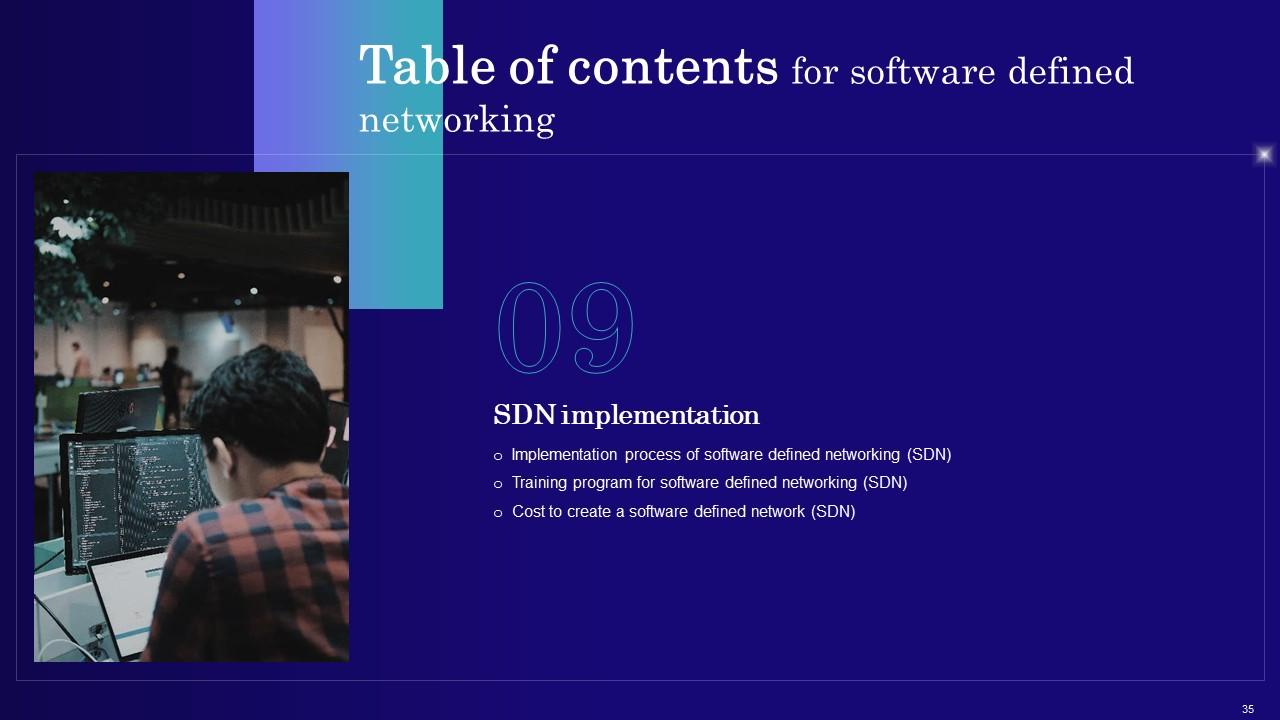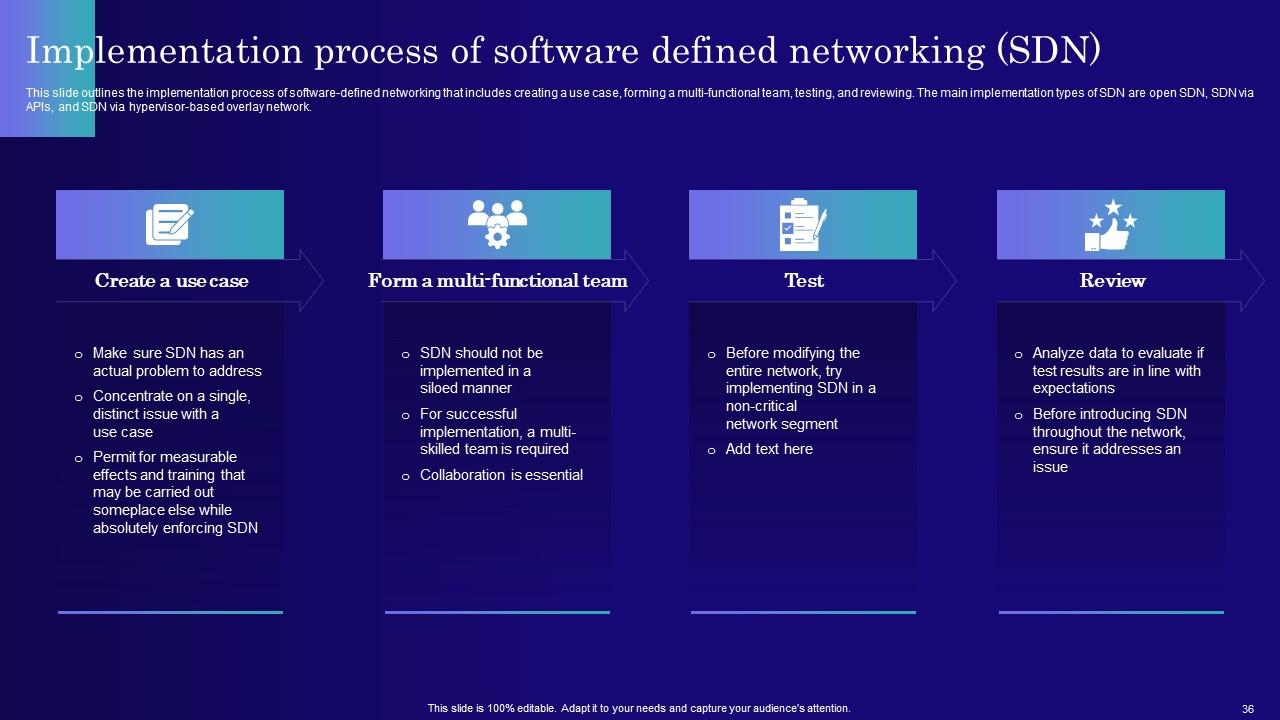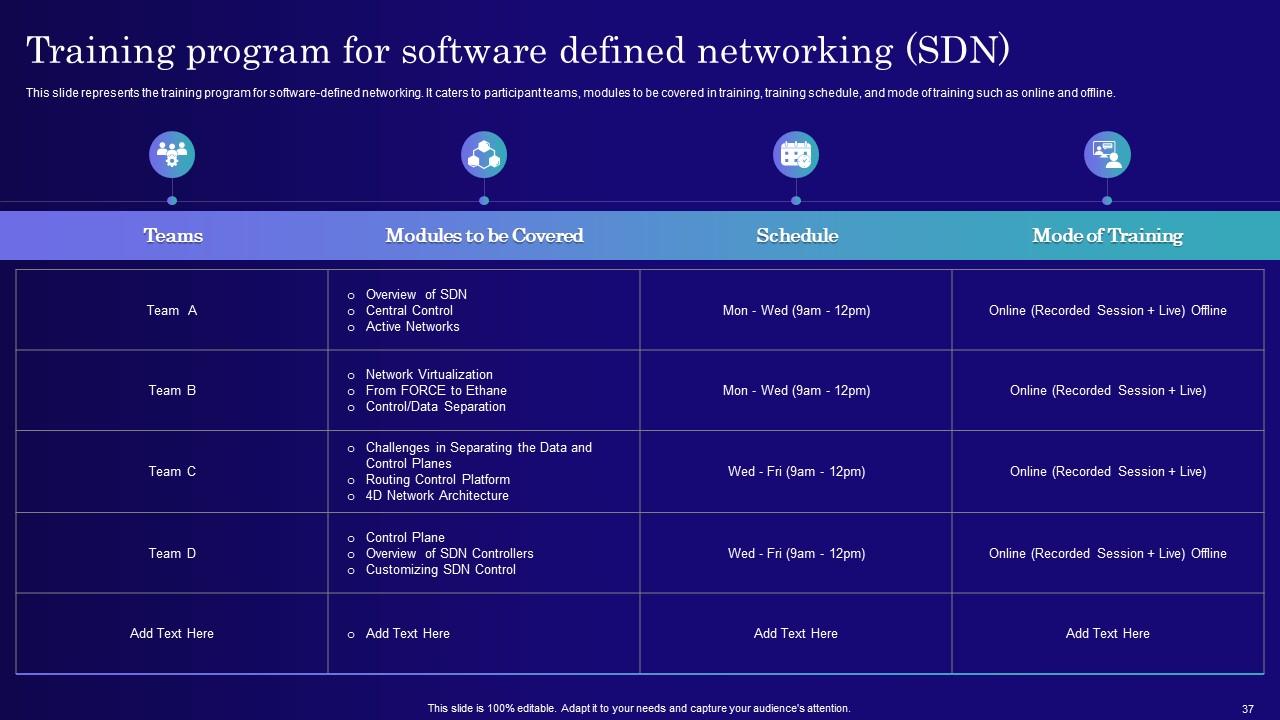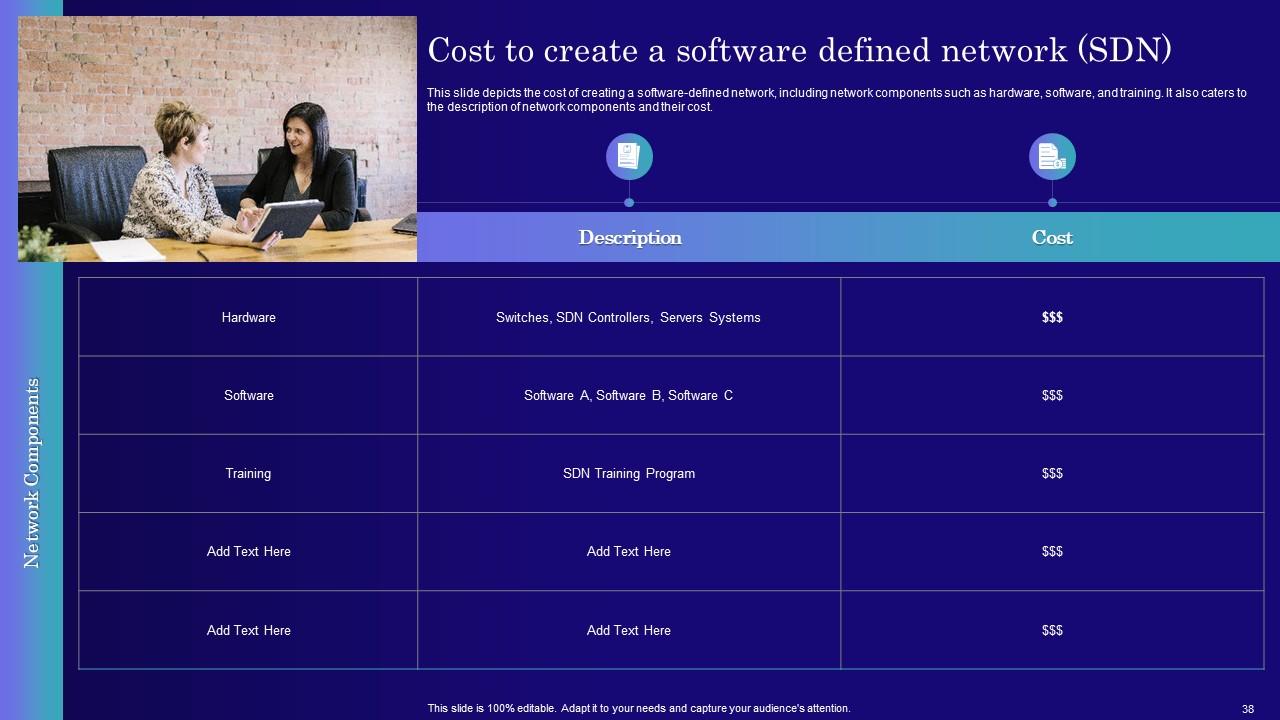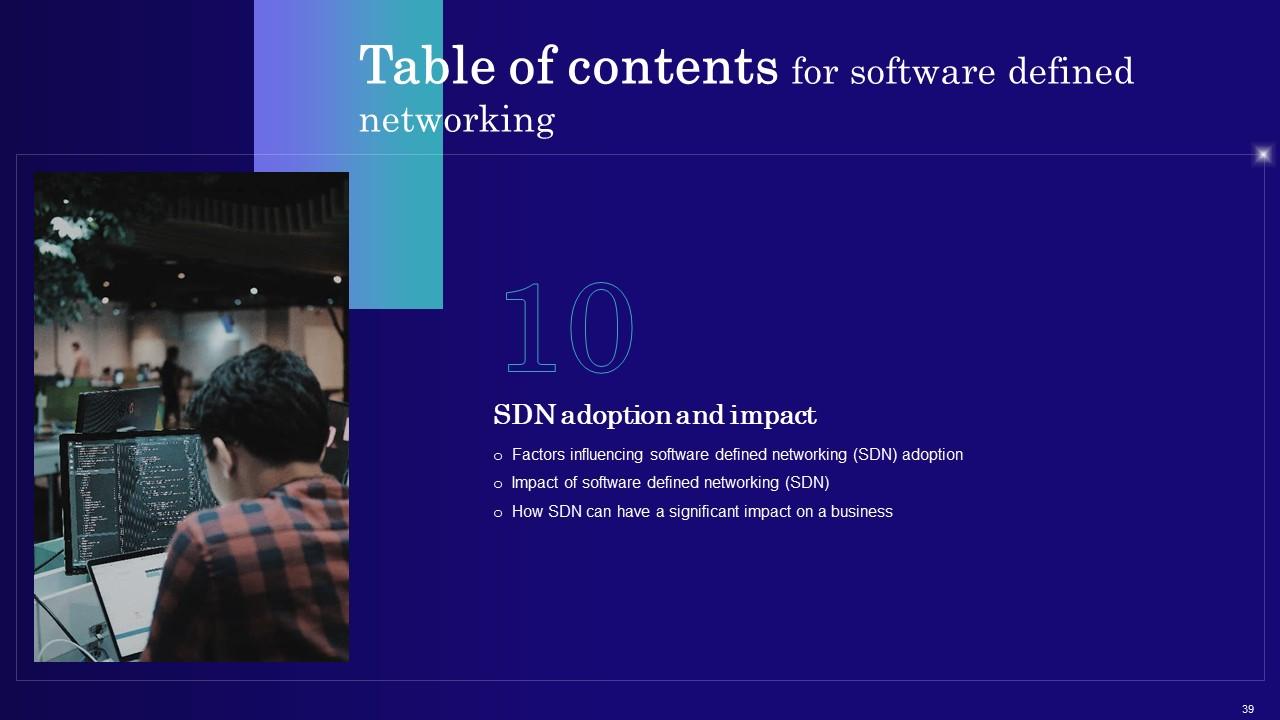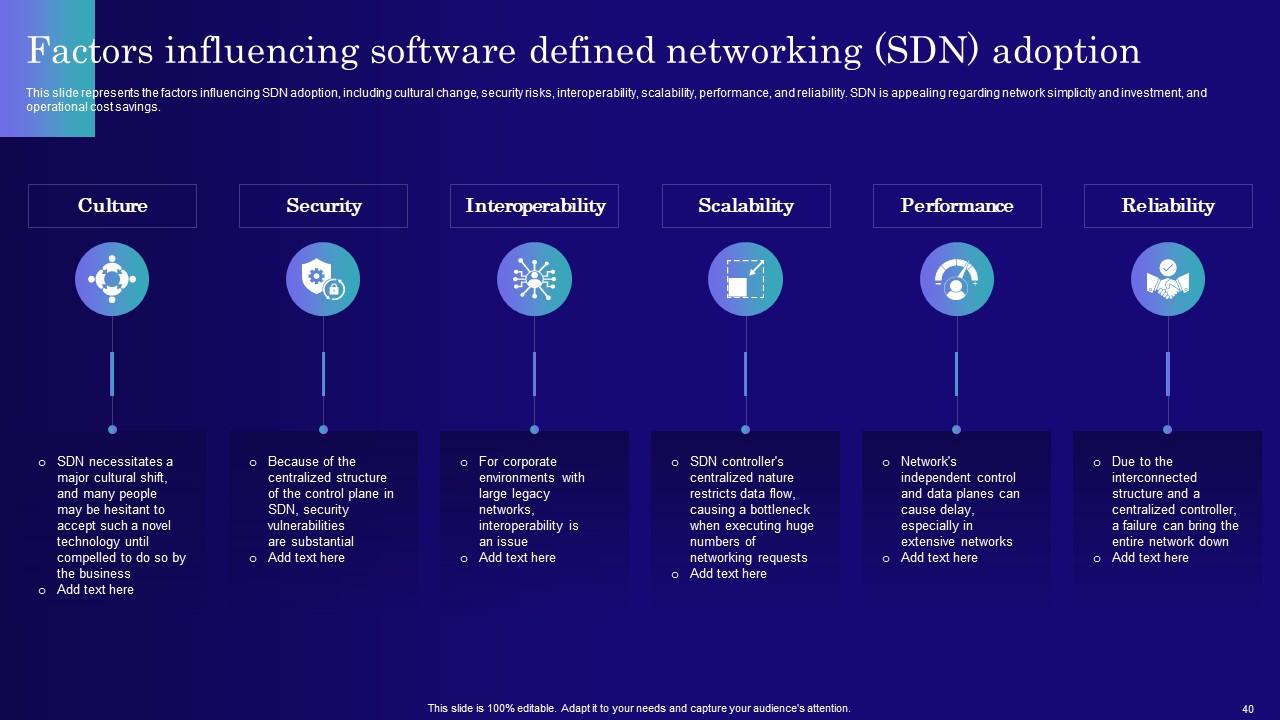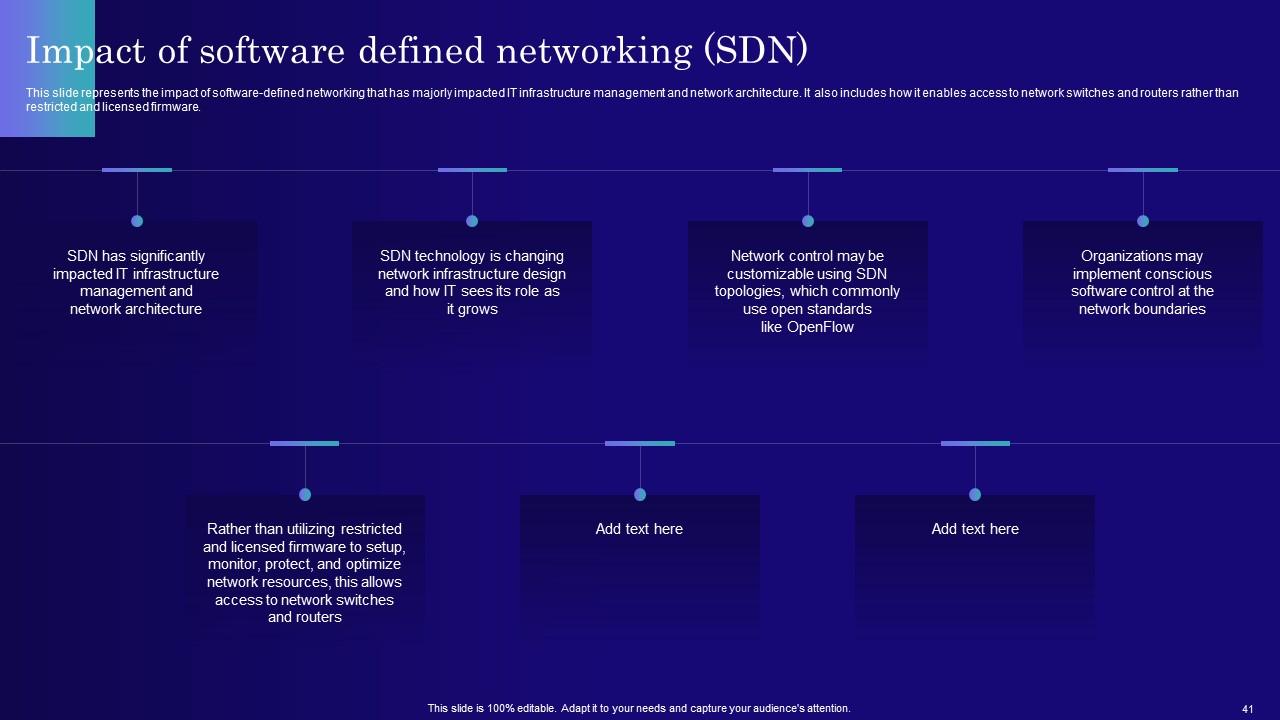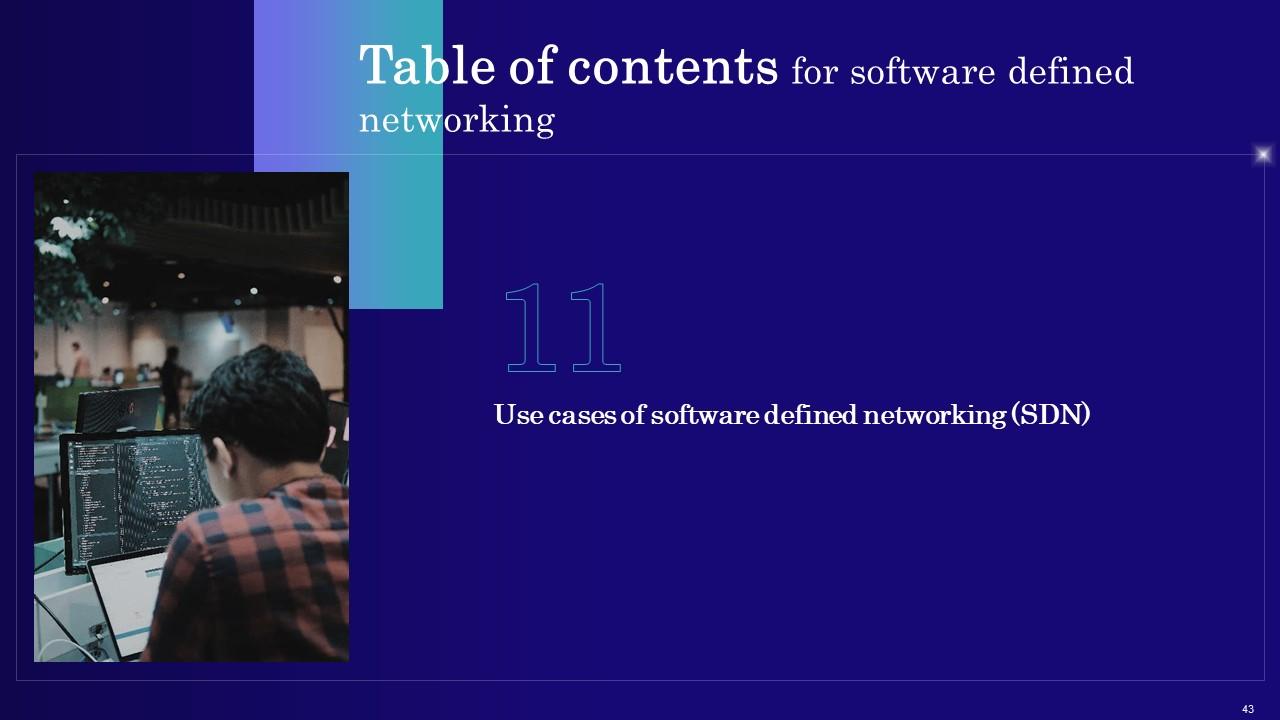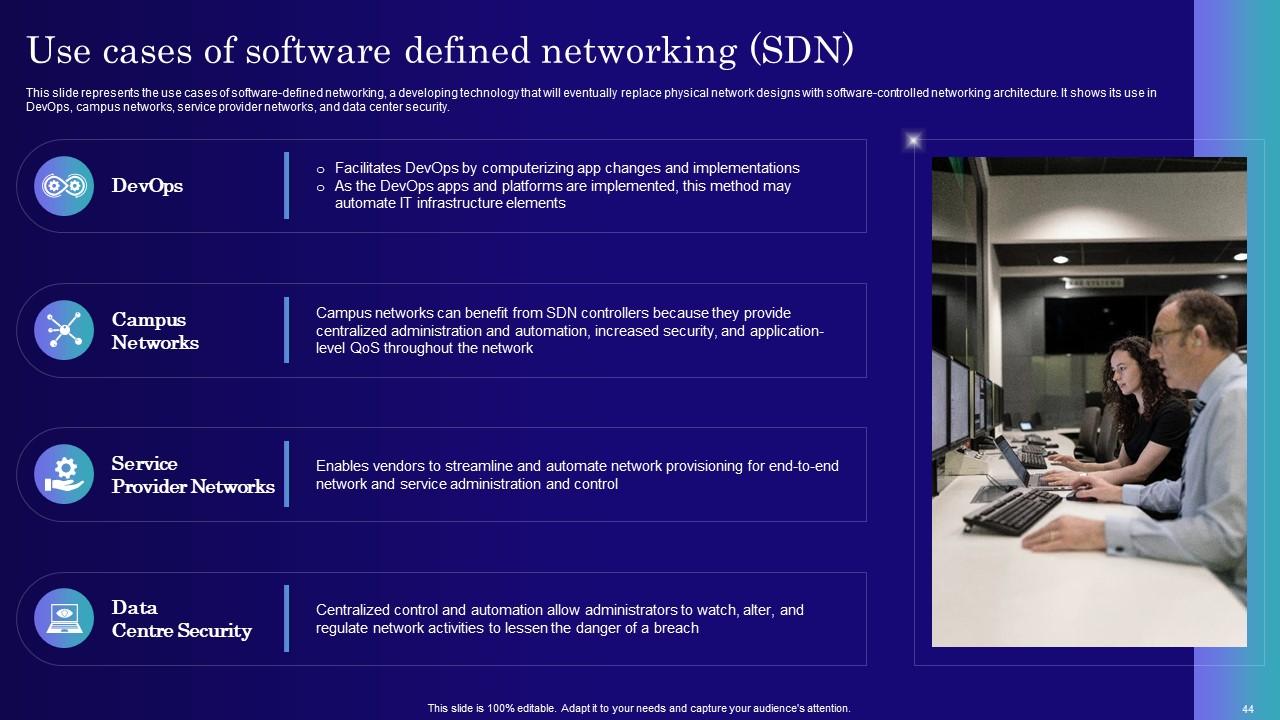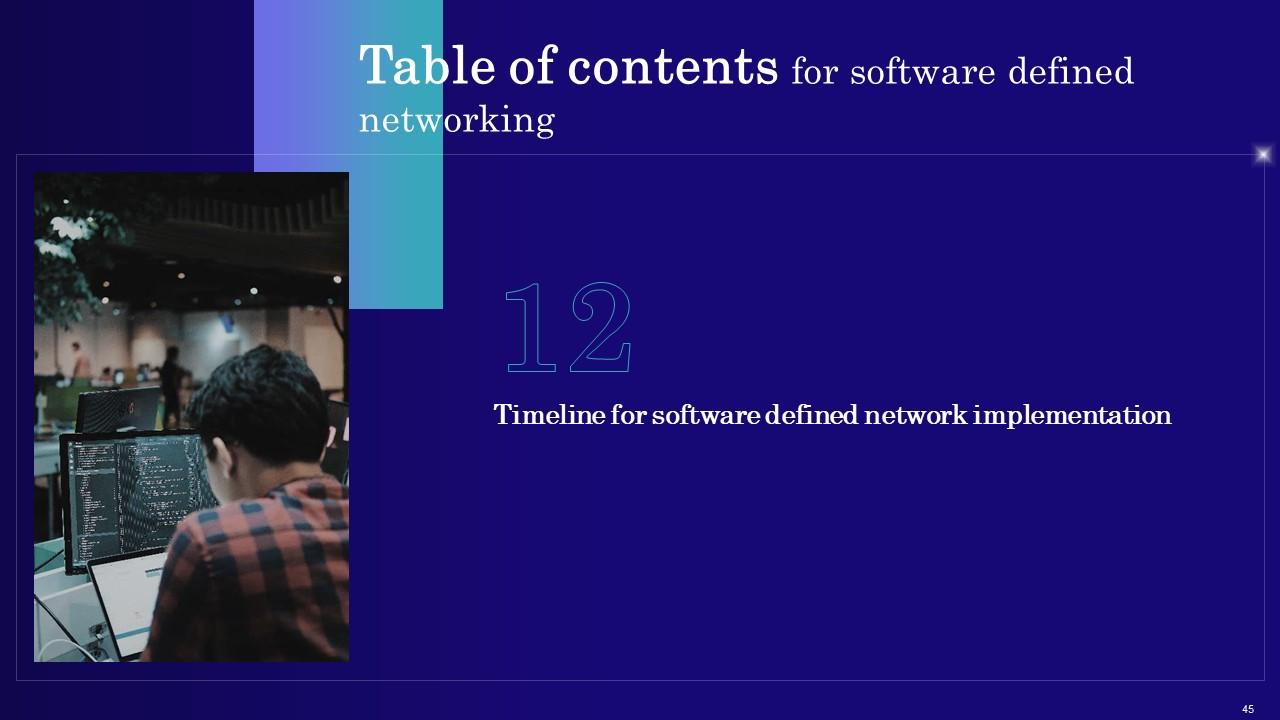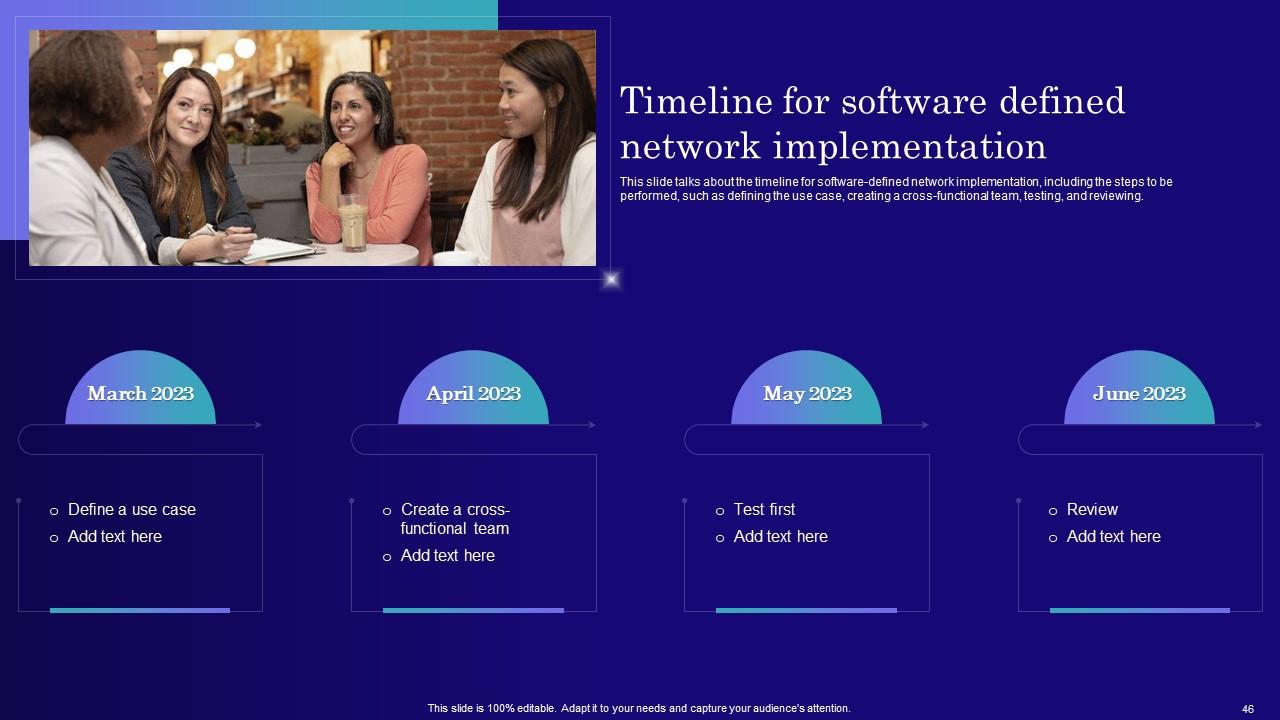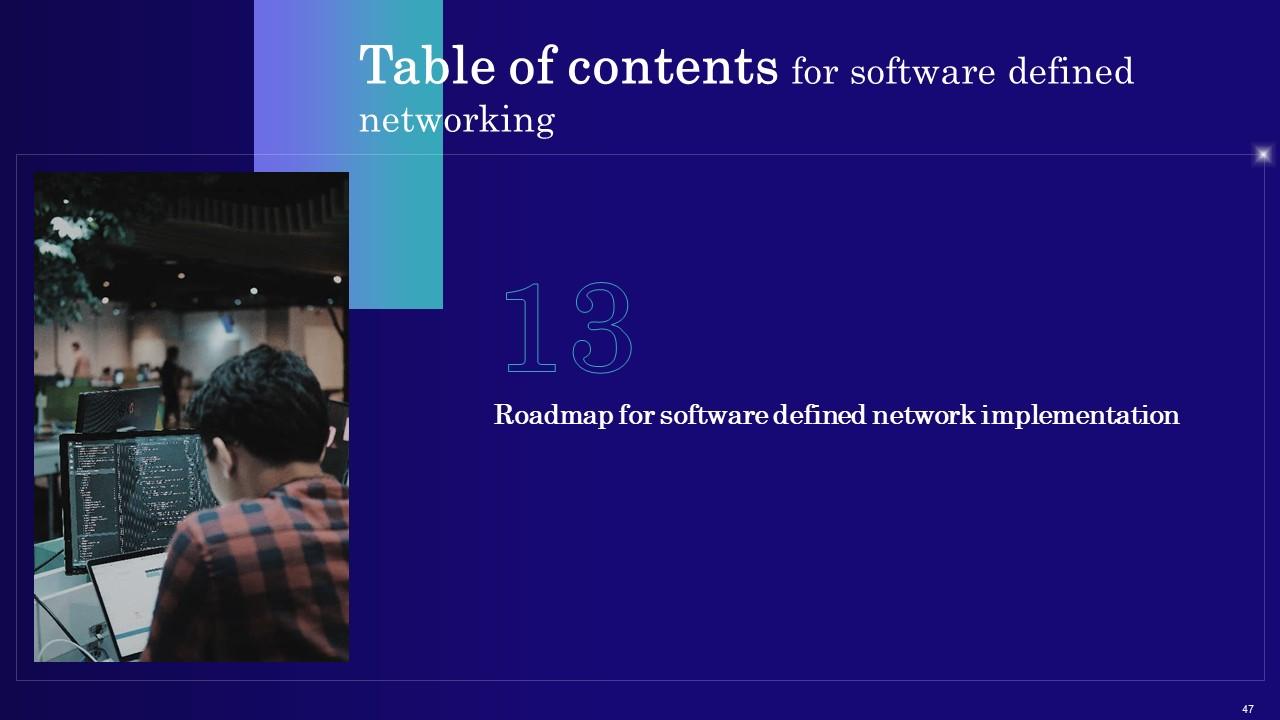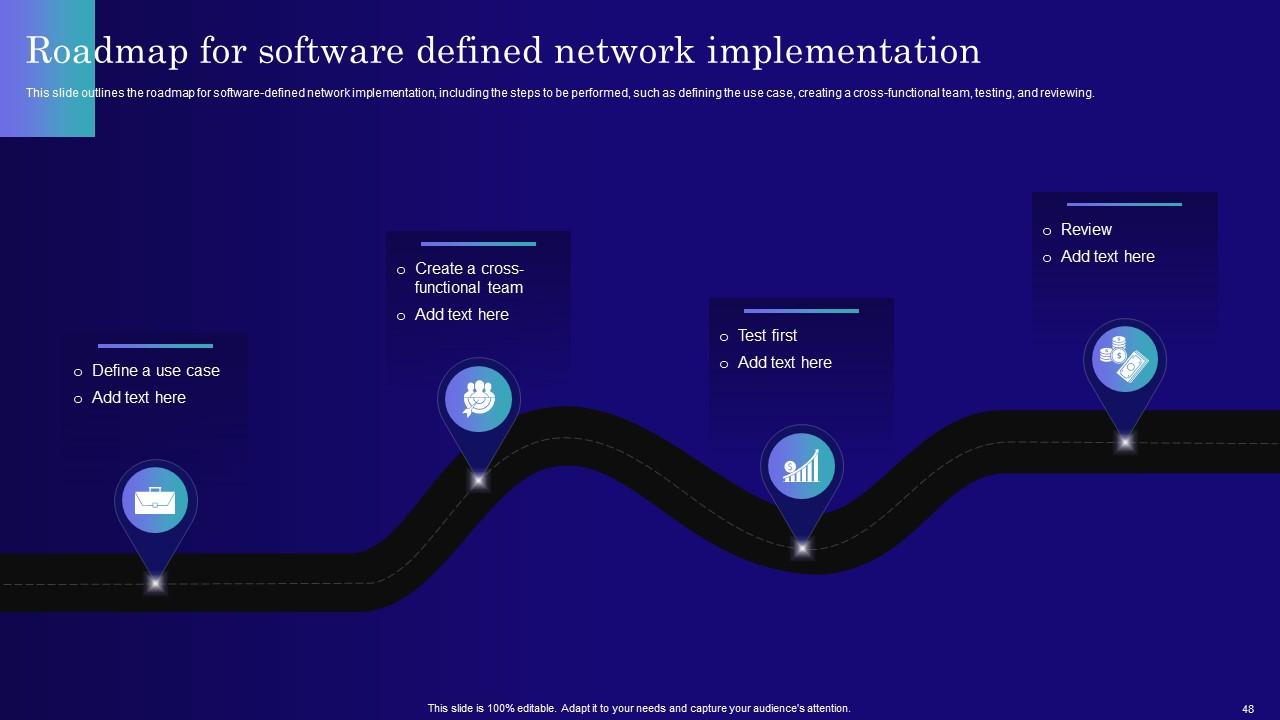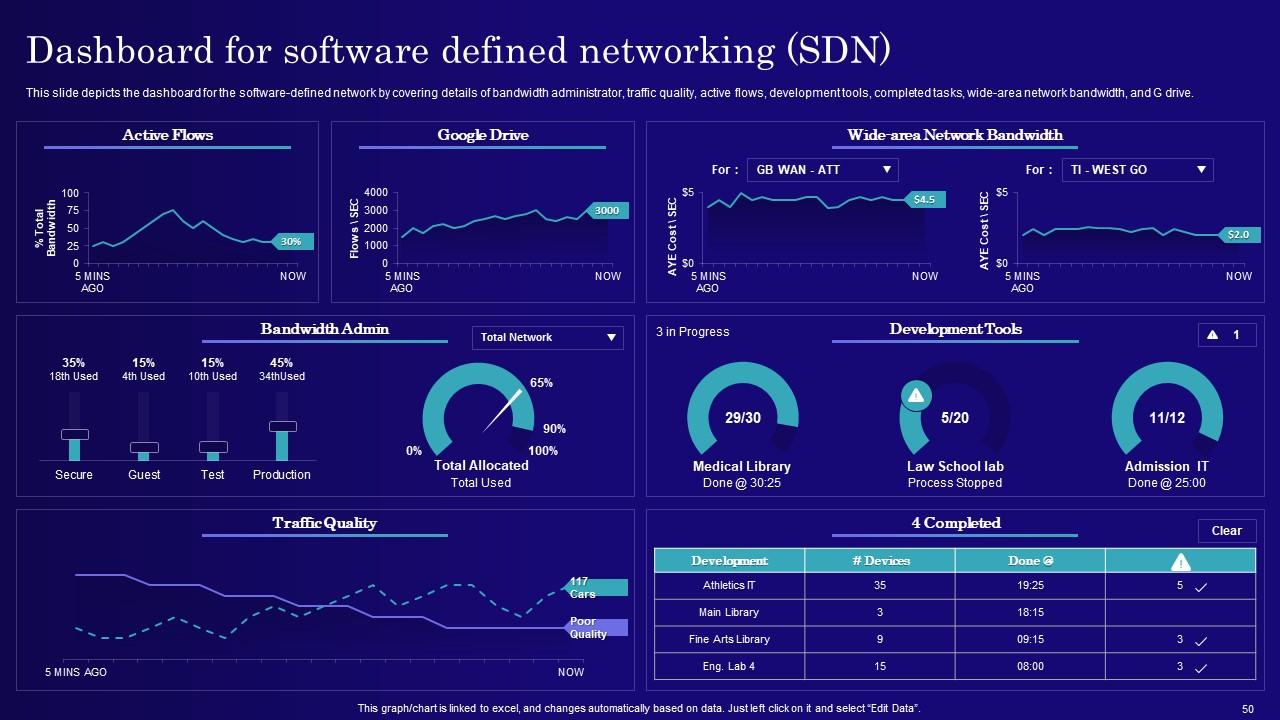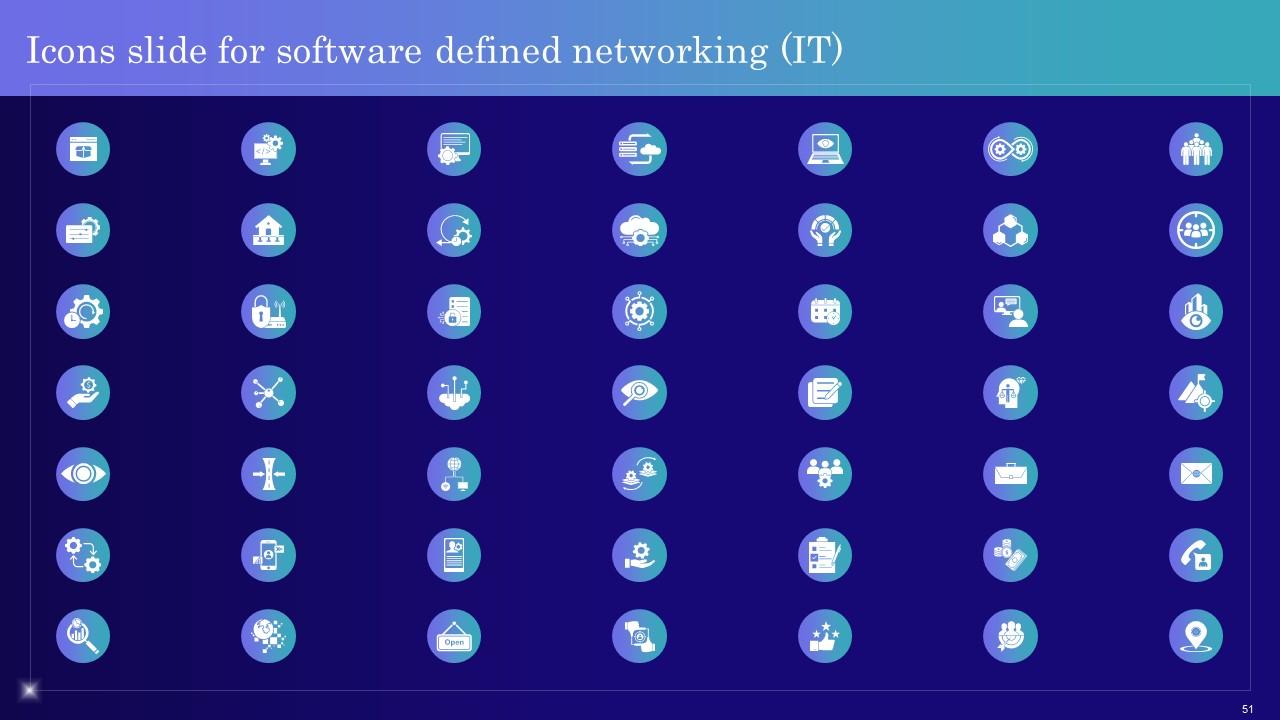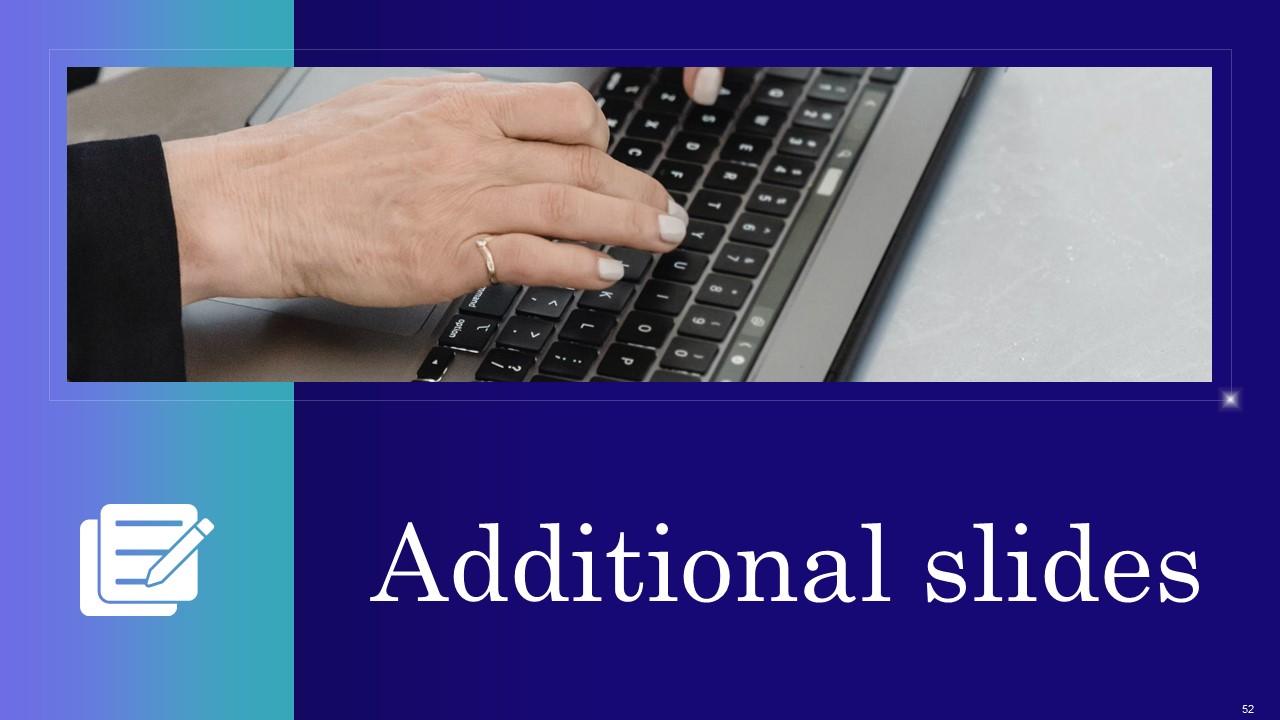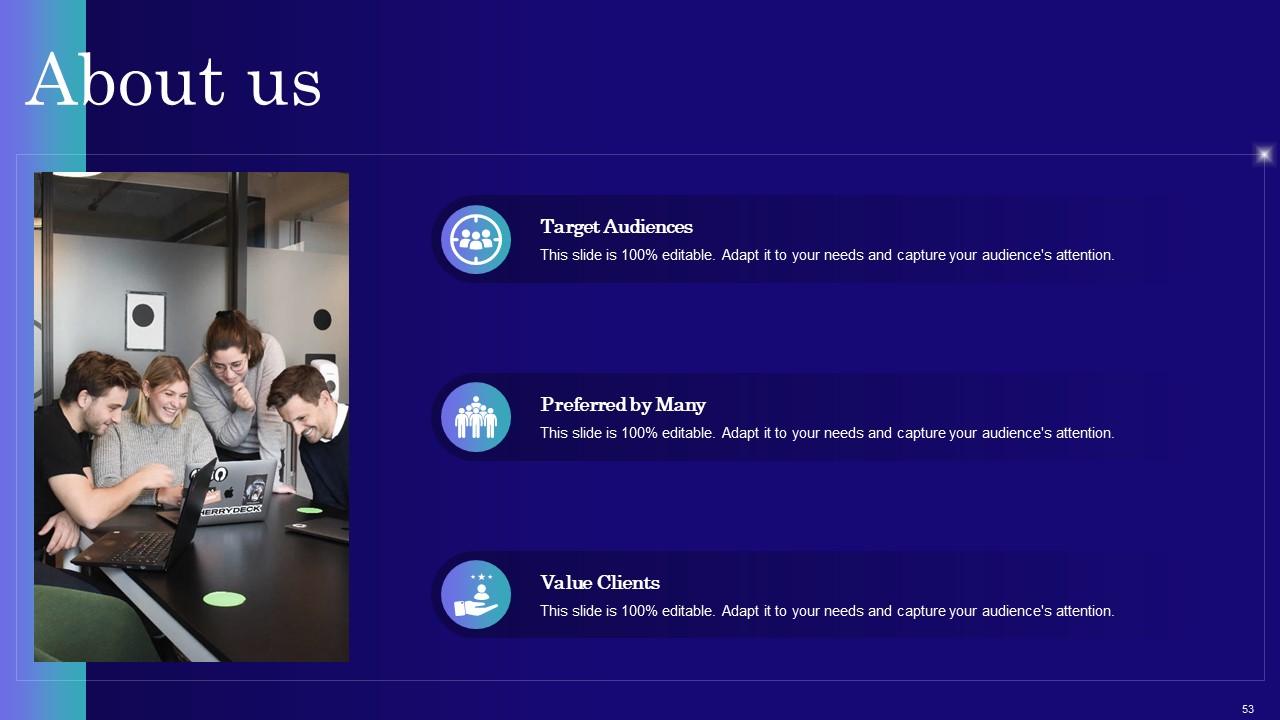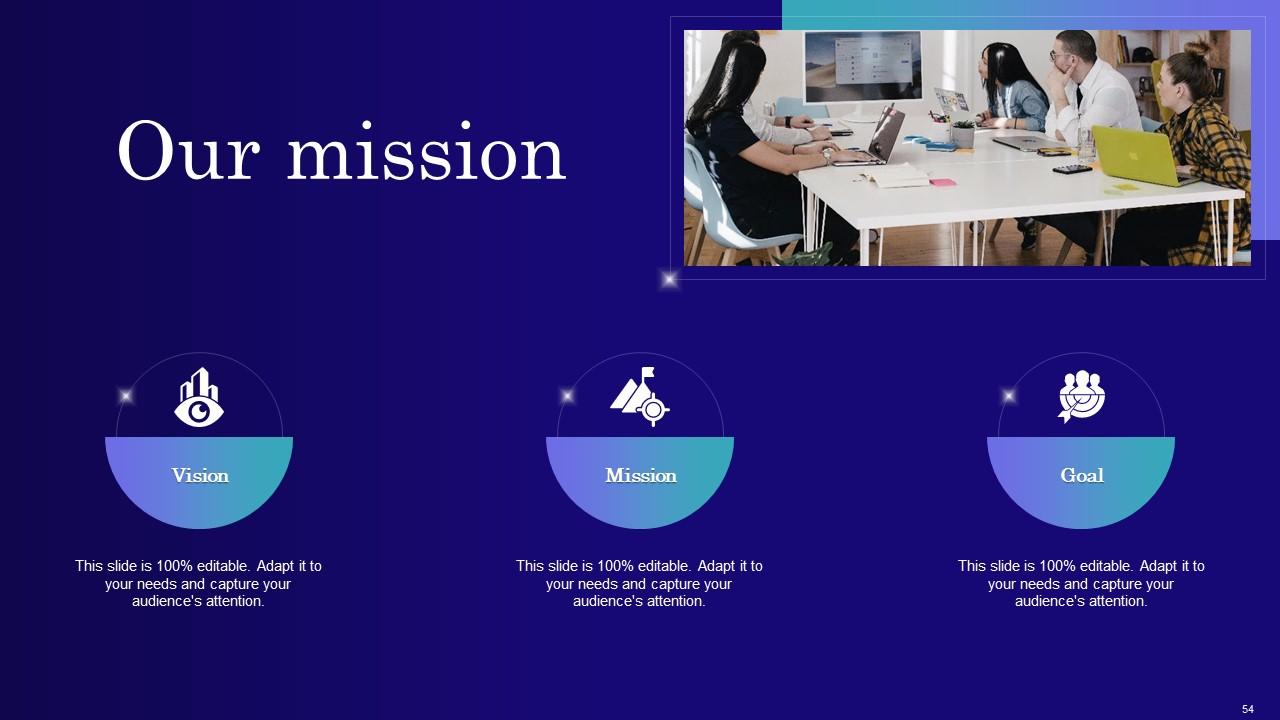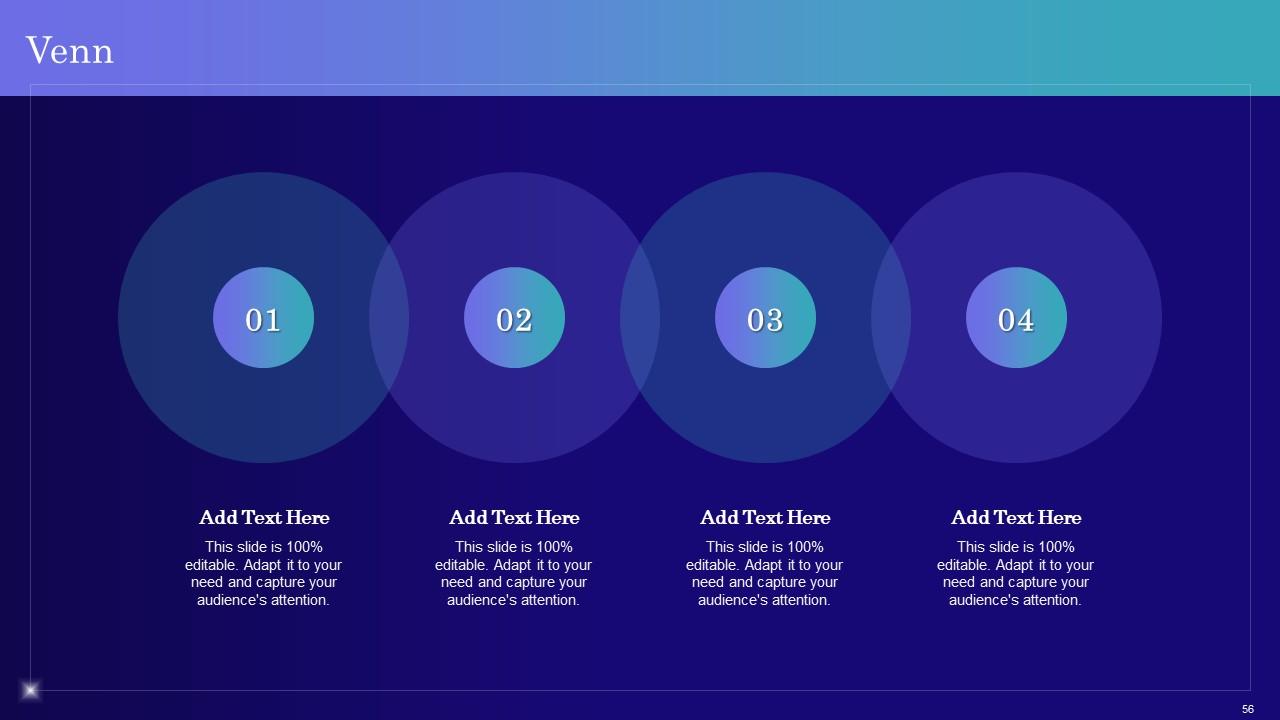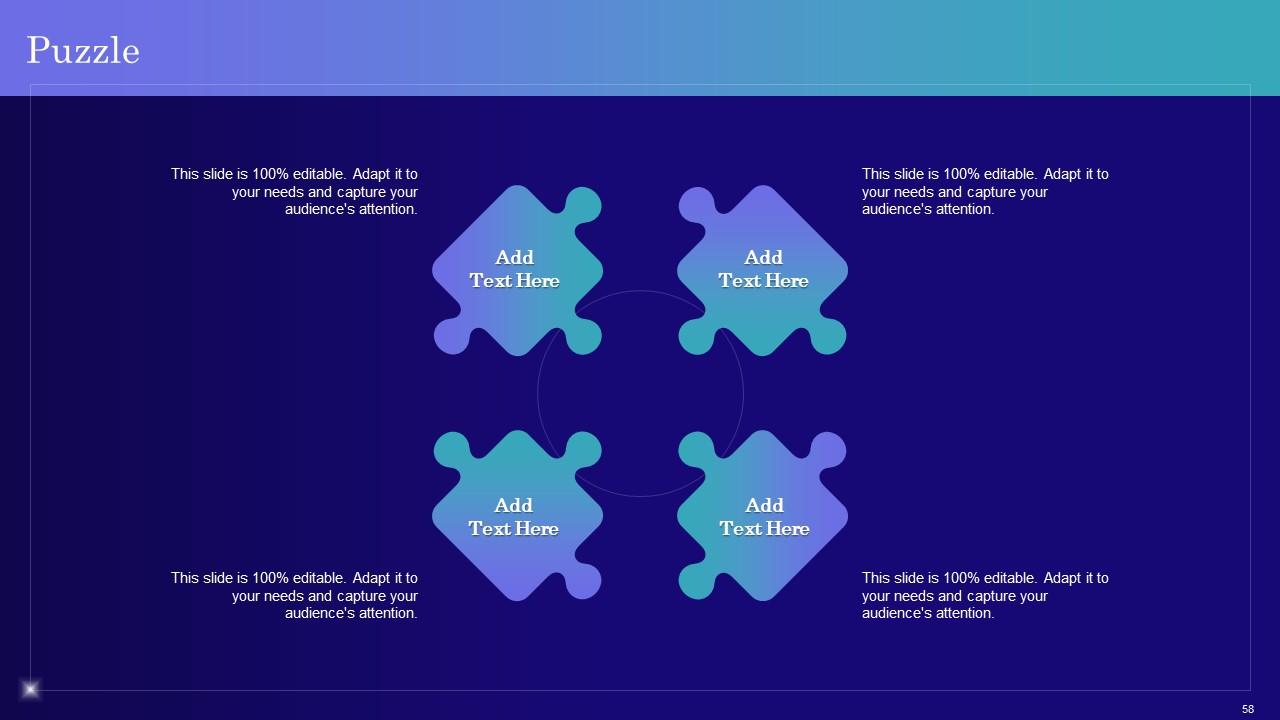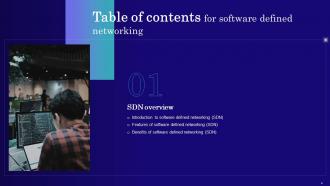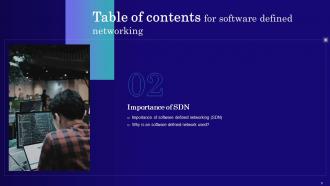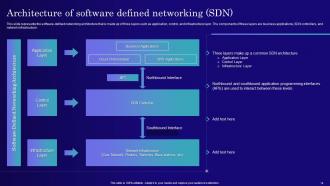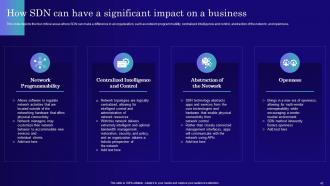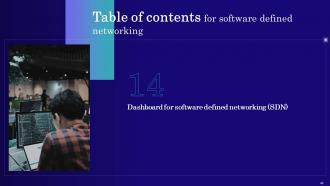Software Defined Networking IT Powerpoint Presentation Slides
This PowerPoint presentation gives a brief idea about the software defined network, including its introduction, features, benefits, importance, and how it differs from traditional networking. In this Software Defined Network PowerPoint Presentation, we have covered the architecture of SDN, its various layers and features, SDN components, models, and its working. In addition, this SDN Overview PPT contains the different development approaches for SDN, such as FORCES, 4D approach, and Ethane. It also covers how SDN plays an essential role in customer security. Also, the Importance of SDN PPT presentation includes the comparison between SDN and SD WAN, Virtualization in SDN, how it can help intent based networking IBN, and the role of SDN in Edge Computing, IoT, and remote access. Furthermore, this SDN Architecture template caters to the implementation plan for SDN, training program, and steps to create SDN. In addition, it also comprises factors influencing SDN adoption and its impact on business. Moreover, this SDN Controller deck comprises use cases of SDN, a timeline and a roadmap for a software defined network, and a performance tracking dashboard. Download our 100 percentage editable and customizable template, which is also compatible with Google Slides.
This PowerPoint presentation gives a brief idea about the software defined network, including its introduction, features, b..
- Google Slides is a new FREE Presentation software from Google.
- All our content is 100% compatible with Google Slides.
- Just download our designs, and upload them to Google Slides and they will work automatically.
- Amaze your audience with SlideTeam and Google Slides.
-
Want Changes to This PPT Slide? Check out our Presentation Design Services
- WideScreen Aspect ratio is becoming a very popular format. When you download this product, the downloaded ZIP will contain this product in both standard and widescreen format.
-

- Some older products that we have may only be in standard format, but they can easily be converted to widescreen.
- To do this, please open the SlideTeam product in Powerpoint, and go to
- Design ( On the top bar) -> Page Setup -> and select "On-screen Show (16:9)” in the drop down for "Slides Sized for".
- The slide or theme will change to widescreen, and all graphics will adjust automatically. You can similarly convert our content to any other desired screen aspect ratio.
Compatible With Google Slides

Get This In WideScreen
You must be logged in to download this presentation.
PowerPoint presentation slides
Deliver this complete deck to your team members and other collaborators. Encompassed with stylized slides presenting various concepts, this Software Defined Networking IT Powerpoint Presentation Slides is the best tool you can utilize. Personalize its content and graphics to make it unique and thought-provoking. All the fifty nine slides are editable and modifiable, so feel free to adjust them to your business setting. The font, color, and other components also come in an editable format making this PPT design the best choice for your next presentation. So, download now.
People who downloaded this PowerPoint presentation also viewed the following :
Content of this Powerpoint Presentation
Slide 1: This slide introduces Software Defined Networking (IT). Commence by stating Your Company Name.
Slide 2: This slide depicts the Agenda of the presentation.
Slide 3: This slide incorporates the Table of contents.
Slide 4: This slide highlights the Title for the Topics to be discussed further.
Slide 5: This slide represents the introduction to software-defined networking that helps network managers to manage network resources faster.
Slide 6: This slide depicts the features of software-defined networking that is intended to make a network more versatile and manageable.
Slide 7: This slide talks about the benefits of software-defined networking, including control, efficiency, management, and visibility.
Slide 8: This slide shows the Heading for the Contents to be covered next.
Slide 9: This slide displays the importance of software-defined networking that allows network administrators to design, create, and run their networks innovatively.
Slide 10: This slide states why the software-defined network is used, including the increase in sales, excellent customer service, etc.
Slide 11: This slide reveals the Title for the Ideas to be covered further.
Slide 12: This slide represents the comparison between software-defined networking and traditional networking based on their working methods.
Slide 13: This slide showcases the Heading for the Ideas to be discussed in the following template.
Slide 14: This slide elucidates the software-defined networking architecture that is made up of three layers such as application, control, and infrastructure layer.
Slide 15: This slide talks about the application layer of the SDN architecture that includes the network applications and functions that businesses deploy.
Slide 16: This slide outlines the control layer of SDN architecture, which is the second layer in the model.
Slide 17: This slide represents the infrastructure layer and Application programming interfaces of SDN architecture.
Slide 18: This slide depicts software-defined networking architecture features that include straight configurable, agile, vendor-neutral, etc.
Slide 19: This slide mentions the Title for the Components to be covered in the next template.
Slide 20: This slide presents the schematic elements of software-defined networking, such as the northbound interface, SDN controller, and southbound interface.
Slide 21: This slide shows the software-defined networking models, covering open SDN, SDN by APIs, SDN overlay model and hybrid SDN.
Slide 22: This slide describes the working of software-defined networking, including its various components.
Slide 23: This slide portrays the Heading for the Topics to be covered further.
Slide 24: This slide displays the forwarding and control element separation methodology of SDN development and caters to the overview and deployment methods.
Slide 25: This slide reveals the 4D methodology of SDN development and includes the architecture and principles of the 4D approach.
Slide 26: This slide discusses the ethane methodology of SDN development by covering its overview and principles.
Slide 27: This slide highlights the Title for the Ideas to be discussed next.
Slide 28: This slide describes the security in software-defined networking, including the security features of SDN architecture such as threat defense, SDN telemetry, segmentation, and DDoS.
Slide 29: This slide portrays the role of software-defined networking in customer security.
Slide 30: This slide highlights the Heading for the Ideas to be covered further.
Slide 31: This slide depicts the comparison between software-defined networking and an SD-WAN.
Slide 32: This slide represents the importance of virtualization in software-defined networking and how they complement one another.
Slide 33: This slide describes how SDN can help with intent-based networking, which comprises many components.
Slide 34: This slide mentions the role of software-defined networking in edge computing, IoT, and remote locations to make them more accessible and less expensive.
Slide 35: This slide reveals the Title for the Topics to be covered next.
Slide 36: This slide outlines the implementation process of software-defined networking that includes creating a use case, forming a multi-functional team, etc.
Slide 37: This slide illustrates the training program for software-defined networking.
Slide 38: This slide depicts the cost of creating a software-defined network, including network components such as hardware, software, and training.
Slide 39: This sldie indicates the Heading for the Contents to be discussed in the following template.
Slide 40: This slide exhibits the Factors influencing software defined networking (SDN) adoption.
Slide 41: This slide elucidates the impact of software-defined networking that has majorly impacted IT infrastructure management and network architecture.
Slide 42: This slide displays the four critical areas where SDN can make a difference in an organization, such as network programmability, centralized intelligence and control, etc.
Slide 43: This slide incorporates the Title for the Components to be discussed further.
Slide 44: This slide showcases the use cases of software-defined networking.
Slide 45: This slide contains the Heading for the Topics to be covered in the forth-coming template.
Slide 46: This slide talks about the timeline for software-defined network implementation, including the steps to be performed.
Slide 47: This slide exhibits the Title for the Topics to be covered in the forth-coming template.
Slide 48: This slide outlines the roadmap for software-defined network implementation, including the steps to be performed.
Slide 49: This slide displays the Heading for the Contents to be discussed next.
Slide 50: This slide illustrates the dashboard for the software-defined network by covering details of bandwidth administrator, traffic quality, active flows, etc.
Slide 51: This is the Icons slide containing all the Icons used in the plan.
Slide 52: This slide is used for showcasing some Additional information.
Slide 53: This is the About us slide. State your company-related information here.
Slide 54: This is Our mission slide. State your organization's mission, vision, and goals here.
Slide 55: This is Our team slide for depicting the information related to team members.
Slide 56: This is the Venn Diagram slide.
Slide 57: This is the 30-60-90 days plan slide for efficient planning.
Slide 58: This is the Puzzle sldie with related imagery.
Slide 59: This is the Thank You slide for acknowledgement
Software Defined Networking IT Powerpoint Presentation Slides with all 64 slides:
Use our Software Defined Networking IT Powerpoint Presentation Slides to effectively help you save your valuable time. They are readymade to fit into any presentation structure.
FAQs
Software Defined Networking (SDN) is an approach to networking that separates the control plane from the data plane, allowing network administrators to manage network services through abstraction of higher-level functionality.
Some of the benefits of Software Defined Networking (SDN) include increased network agility, simplified network management, improved security, and reduced costs.
Software Defined Networking (SDN) differs from traditional networking by separating the control plane from the data plane, which allows for greater flexibility and easier management of network resources.
Common use cases for Software Defined Networking (SDN) include data center networking, network virtualization, network automation, and network security.
Some of the challenges of implementing Software Defined Networking (SDN) include the need for new hardware and software, changes to network architecture, and the need for trained personnel to manage the network.
-
Happy to incorporate such stunning templates in my presentation. Made my presentation look professional and engaging.
-
Fantastic and innovative graphics with useful content. The templates are the best and latest in the industry.


